|

|
|
AGENDA
Strategy, Finance and Risk Committee meeting
Monday, 19 February 2024
|
|
I hereby give notice that a Strategy, Finance and
Risk Committee meeting will be held on:
|
|
Date:
|
Monday, 19 February 2024
|
|
Time:
|
9.30am
|
|
Location:
|
Bay of Plenty Regional Council Chambers
Regional House
1 Elizabeth Street
Tauranga
|
|
Please note that this
meeting will be livestreamed and the recording will be publicly available on
Tauranga City Council's website: www.tauranga.govt.nz.
|
|
Marty Grenfell
Chief Executive
|
Terms of reference – Strategy,
Finance & Risk Committee
Membership
|
Chairperson
|
Commission Chair Anne Tolley
|
|
Deputy chairperson
|
Dr Wayne Beilby – Tangata
Whenua representative
|
|
Members
|
Commissioner Shadrach Rolleston
Commissioner Stephen Selwood
Commissioner Bill Wasley
|
|
|
Matire Duncan, Te Rangapū Mana
Whenua o Tauranga Moana Chairperson
Te Pio Kawe – Tangata
Whenua representative
Rohario Murray – Tangata
Whenua representative
Bruce Robertson – External
appointee with finance and risk experience
|
|
Quorum
|
Five (5) members must be
physically present, and at least three (3) commissioners and two (2)
externally appointed members must be present.
|
|
Meeting frequency
|
Six weekly
|
Role
The role
of the Strategy, Finance and Risk Committee (the Committee) is:
(a)
to assist and advise the Council in discharging
its responsibility and ownership of health and safety, risk management,
internal control, financial management practices, frameworks and processes to
ensure these are robust and appropriate to safeguard the Council's staff and
its financial and non-financial assets;
(b)
to consider strategic issues facing the city and
develop a pathway for the future;
(c)
to monitor progress on achievement of desired
strategic outcomes;
(d)
to review and determine the policy and bylaw
framework that will assist in achieving the strategic priorities and outcomes
for the Tauranga City Council.
Membership
The Committee will consist of:
· four
commissioners with the Commission Chair appointed as the Chairperson of the
Committee
· the
Chairperson of Te Rangapū Mana Whenua o Tauranga Moana
· three
tangata whenua representatives (recommended by Te Rangapū Mana Whenua o
Tauranga Moana and appointed by Council)
· an
independent external person with finance and risk experience appointed by the
Council.
Voting
Rights
The
tangata whenua representatives and the independent external person have voting
rights as do the Commissioners.
The
Chairperson of Te Rangapu Mana Whenua o Tauranga Moana is an advisory position,
without voting rights, designed to ensure mana whenua discussions are connected
to the committee.
Committee's
Scope and Responsibilities
A. STRATEGIC
ISSUES
The Committee will consider
strategic issues, options, community impact and explore opportunities for
achieving outcomes through a partnership approach.
A1 – Strategic Issues
The Committee's responsibilities with regard to Strategic
Issues are:
· Adopt
an annual work programme of significant strategic issues and projects to be
addressed. The work programme will be reviewed on a six-monthly basis.
· In
respect of each issue/project on the work programme, and any additional matters
as determined by the Committee:
o
Consider existing and future strategic context
o
Consider opportunities and possible options
o
Determine preferred direction and pathway forward and recommend
to Council for inclusion into strategies, statutory documents (including City
Plan) and plans.
· Consider
and approve changes to service delivery arrangements arising from the service
delivery reviews required under Local Government Act 2002 that are referred to
the Committee by the Chief Executive.
· To
take appropriate account of the principles of the Treaty of Waitangi.
A2 – Policy and Bylaws
The Committee's responsibilities with regard to Policy and
Bylaws are:
· Develop,
review and approve bylaws to be publicly consulted on, hear and deliberate on
any submissions and recommend to Council the adoption of the final bylaw. (The
Committee will recommend the adoption of a bylaw to the Council as the Council
cannot delegate to a Committee the adoption of a bylaw.)
· Develop,
review and approve policies including the ability to publicly consult, hear and
deliberate on and adopt policies.
A3 – Monitoring of Strategic
Outcomes and Long Term Plan and Annual Plan
The Committee's responsibilities with regard to monitoring
of strategic outcomes and Long Term Plan and Annual Plan are:
· Reviewing
and reporting on outcomes and action progress against the approved strategic
direction. Determine any required review / refresh of strategic direction or
action pathway.
· Reviewing
and assessing progress in each of the six (6) key investment proposal areas
within the 2021-2031 Long Term Plan.
· Reviewing
the achievement of financial and non-financial performance measures against the
approved Long Term Plan and Annual Plans.
B. FINANCE AND RISK
The Committee will review the effectiveness of the
following to ensure these are robust and appropriate to safeguard the Council's
financial and non-financial assets:
· Health
and safety.
· Risk
management.
· Significant
projects and programmes of work focussing on the appropriate management of risk.
· Internal
and external audit and assurance.
· Fraud,
integrity and investigations.
· Monitoring
of compliance with laws and regulations.
· Oversight
of preparation of the Annual Report and other external financial reports
required by statute.
· Oversee
the relationship with the Council’s Investment Advisors and Fund
Managers.
· Oversee
the relationship between the Council and its external auditor.
· Review
the quarterly financial and non-financial reports to the Council.
B1 - Health and Safety
The
Committee’s responsibilities through regard to health and safety are:
· Reviewing
the effectiveness of the health and safety policies and processes to ensure a
healthy and safe workspace for representatives, staff, contractors, visitors
and the public.
· Assisting
the Commissioners to discharge their statutory roles as "Officers" in
terms of the Health and Safety at Work Act 2015.
B2 - Risk Management
The
Committee's responsibilities with regard to risk management are:
· Review,
approve and monitor the implementation of the Risk Management Policy, including
the Corporate Risk Register.
· Review
and approve the Council’s "risk appetite" statement.
· Review
the effectiveness of risk management and internal control systems including all
material financial, operational, compliance and other material controls. This
includes legislative compliance, significant projects and programmes of work,
and significant procurement.
· Review
risk management reports identifying new and/or emerging risks and any
subsequent changes to the "Tier One" register.
B3
- Internal Audit
The
Committee’s responsibilities with regard to the Internal Audit are:
· Review
and approve the Internal Audit Charter to confirm the authority, independence
and scope of the Internal Audit function. The Internal Audit Charter may be
reviewed at other times and as required.
· Review
and approve annually and monitor the implementation of the Internal Audit Plan.
· Review
the co-ordination between the risk and internal audit functions, including the
integration of the Council's risk profile with the Internal Audit programme.
This includes assurance over all material financial, operational, compliance
and other material controls. This includes legislative compliance (including
Health and Safety), significant projects and programmes of work and significant
procurement.
· Review
the reports of the Internal Audit functions dealing with findings, conclusions
and recommendations.
· Review
and monitor management’s responsiveness to the findings and
recommendations and enquire into the reasons that any recommendation is not
acted upon.
B4
- External Audit
The
Committee's responsibilities with regard to the External Audit are:
· Review
with the external auditor, before the audit commences, the areas of audit focus
and audit plan.
· Review
with the external auditors, representations required by commissioners and
senior management, including representations as to the fraud and integrity
control environment.
· Recommend
adoption of external accountability documents (LTP and annual report) to the
Council.
· Review
the external auditors, management letter and management responses and inquire
into reasons for any recommendations not acted upon.
· Where
required, the Chair may ask a senior representative of the Office of the
Auditor General (OAG) to attend the Committee meetings to discuss the OAG's
plans, findings and other matters of mutual interest.
· Recommend
to the Office of the Auditor General the decision either to publicly tender the
external audit or to continue with the existing provider for a further
three-year term.
B5
- Fraud and Integrity
The
Committee's responsibilities with regard to Fraud and Integrity are:
· Review
and provide advice on the Fraud Prevention and Management Policy.
· Review,
adopt and monitor the Protected Disclosures Policy.
· Review
and monitor policy and process to manage conflicts of interest amongst
commissioners, tangata whenua representatives, external representatives
appointed to council committees or advisory boards, management, staff,
consultants and contractors.
· Review
reports from Internal Audit, external audit and management related to protected
disclosures, ethics, bribery and fraud related incidents.
· Review
and monitor policy and processes to manage responsibilities under the Local
Government Official Information and Meetings Act 1987 and the Privacy Act 2020
and any actions from the Office of the Ombudsman's report.
B6
- Statutory Reporting
The
Committee's responsibilities with regard to Statutory Reporting relate to
reviewing and monitoring the integrity of the Annual Report and recommending to
the Council for adoption the statutory financial statements and any other
formal announcements relating to the Council's financial performance, focusing
particularly on:
· Compliance
with, and the appropriate application of, relevant accounting policies,
practices and accounting standards.
· Compliance
with applicable legal requirements relevant to statutory reporting.
· The
consistency of application of accounting policies, across reporting periods.
· Changes
to accounting policies and practices that may affect the way that accounts are
presented.
· Any
decisions involving significant judgement, estimation or uncertainty.
· The
extent to which financial statements are affected by any unusual transactions
and the manner in which they are disclosed.
· The
disclosure of contingent liabilities and contingent assets.
· The
basis for the adoption of the going concern assumption.
· Significant
adjustments resulting from the audit.
Power
to Act
· To
make all decisions necessary to fulfil the role, scope and responsibilities of
the Committee subject to the limitations imposed.
· To
establish sub-committees, working parties and forums as required.
· This
Committee has not been delegated any responsibilities, duties or
powers that the Local Government Act 2002, or any other Act, expressly provides
the Council may not delegate. For the avoidance of doubt, this Committee has not
been delegated the power to:
o
make a rate;
o
make a bylaw;
o
borrow money, or purchase or dispose of assets, other than in
accordance with the Long-Term Plan (LTP);
o
adopt the LTP or Annual Plan;
o
adopt the Annual Report;
o
adopt any policies required to be adopted and consulted on in
association with the LTP or developed for the purpose of the local governance
statement;
o
adopt a remuneration and employment policy;
o
appoint a chief executive.
Power
to Recommend
To Council and/or any standing committee
as it deems appropriate.
|
Strategy,
Finance and Risk Committee meeting Agenda
|
19
February 2024
|
7 Confirmation
of minutes
7.1 Minutes
of the Strategy, Finance and Risk Committee meeting held on 4 December 2023
File
Number: A15491507
Author: Anahera
Dinsdale, Governance Advisor
Authoriser: Anahera
Dinsdale, Governance Advisor
|
Recommendations
That the Minutes of the
Strategy, Finance and Risk Committee meeting held on 4 December 2023 be
confirmed as a true and correct record.
|
Attachments
1. Minutes
of the Strategy, Finance and Risk Committee meeting held on 4 December
2023
|
 Strategy, Finance and Risk Committee meeting minutes Strategy, Finance and Risk Committee meeting minutes
|
4 December 2023
|
|

|
|
MINUTES
Strategy, Finance and Risk Committee meeting
Monday, 4 December 2023
|
Order of Business
1 Opening karakia. 3
2 Apologies. 3
3 Public forum.. 3
4 Acceptance of
late items. 4
4.1 Acceptance
of late item - Local Alcohol Policy - Legal Advice (public excluded) 4
5 Confidential
business to be transferred into the open. 4
6 Change to order
of business. 4
7 Confirmation of
minutes. 4
7.1 Minutes
of the Strategy, Finance and Risk Committee meeting held on 30 October 2023. 4
7.2 Minutes
of the Strategy, Finance and Risk Committee meeting held on 13 November 2023. 5
8 Declaration of
conflicts of interest 5
9 Business. 5
9.1 Refreshed
outline plan of the Committee's upcoming work programme. 5
9.2 Priority
One Annual Report 2022/2023. 6
9.3 Mount
Industrial Planning Study Key Recommendations. 8
9.8 Review
of policies on grants for development contributions on Papakāinga Housing
and Community Housing. 11
9.4 Delivering
on Our Direction - keeping it live. 13
9.5 Audit
New Zealand - report to the commissioners on the audit of the consultation
document for the 2024-34 long-term plan. 14
9.6 Growth
& Land Use Projects Progress Report - December 2023. 14
9.7 City
Plan Work Programme. 16
9.9 Deliberations
Report on the Street Use Policy. 17
9.10 Deliberations
Report for Traffic and Parking Bylaw.. 18
9.11 Deliberations
Report - Gambling Venues Policy. 19
9.12 LGOIMA
and Privacy Report Q1 for 2023/2024 year 20
10 Discussion of late items. 20
11 Public excluded session. 20
11.1 Corporate
Risk Register - Quarterly Update. 21
11.2 Internal
Audit & Assurance - Quarterly Update. 21
11.3 Litigation
Report 21
11.4 Local
Alcohol Policy – Legal Advice. 22
12 Closing karakia. 22
MINUTES
OF Tauranga City Council
Strategy, Finance and Risk Committee meeting
HELD
AT THE Bay of Plenty Regional Council
Chambers,
Regional House, 1 Elizabeth Street, Tauranga
ON
Monday, 4 December 2023 AT 9.30am
PRESENT: Commission
Chair Anne Tolley (Chairperson), Commissioner Shadrach Rolleston, Commissioner
Stephen Selwood, Mr Te Pio Kawe, Ms Rohario Murray
IN ATTENDANCE: Marty
Grenfell (Chief Executive), Paul Davidson (Chief Financial Officer), Barbara
Dempsey (General Manager: Community Services), Nic Johansson (General Manager:
Infrastructure), Christine Jones (General Manager: Strategy, Growth &
Governance), Ceilidh Dunphy (Acting General Manager: Corporate Services), Sarah
Omundsen (General Manager: Regulatory and Compliance), Lisa Gilmour (City
Partnership Specialist), Carlo Ellis (Manager: Strategic Māori Engagement), Carl
Lucca (Team Leader: Urban Communities), Jeremy Boase (Manager: Strategy &
Corporate Planning), Andy Mead (Manager: City Planning & Growth), Janine
Speedy (Team Leader: City Planning), Sharon Herbst (Policy Analyst), Richard
Butler (Community Partnerships Funding Specialist), Ruth Woodward (Team Leader:
Policy), Vicky Grant-Ussher (Policy Analyst), Jennifer Ross (Policy Analyst),
Nigel McGlone (Manager: Environmental Regulation), Reece Wilkinson (Parking
Strategy Manager), Coral Hair (Manager: Democracy & Governance Services),
Anahera Dinsdale (Governance Advisor),
EXTERNAL: Nigel
Tutt (Chief Executive) and Greg Simmonds (General Manager: Workforce and
Policy), (Priority One) and David Phizacklea (Consultant – Mount
Maunganui Industrial Study),
1 Opening
karakia
Commissioner Shadrach Rolleston opened the meeting with a
karakia.
2 Apologies
|
Committee Resolution SFR9/23/1
Moved: Commissioner
Stephen Selwood
Seconded: Ms Rohario Murray
That apologies from Dr Wayne Beilby, Commissioner Bill
Wasley, Ms Matire Duncan and Mr Bruce Robertson be received and accepted.
Carried
|
3 Public
forum
None
4 Acceptance
of late items
|
4.1 Acceptance
of late item - Local Alcohol Policy - Legal Advice (public excluded)
|
|
Committee Resolution SFR9/23/2
Moved: Commissioner
Shadrach Rolleston
Seconded: Commissioner Stephen Selwood
That the Strategy, Finance and Risk Committee:
(a)
Accepts the late tabled report "Local
Alcohol Policy – Legal Advice" to be considered in the public
excluded section of the meeting as the legal advice was received after the
agenda, it cannot be delayed to a subsequent meeting as there was a statutory
timeframe to a decision which expires on 10 December 2023.
Carried
|
5 Confidential
business to be transferred into the open
None
6 Change
to order of business
None
7 Confirmation
of minutes
|
7.1 Minutes
of the Strategy, Finance and Risk Committee meeting held on 30 October 2023
|
|
Committee Resolution SFR9/23/3
Moved: Commissioner
Shadrach Rolleston
Seconded: Commissioner Stephen Selwood
That the minutes
of the Strategy, Finance and Risk Committee meeting held on 30 October 2023
be confirmed as a true and correct record subject to the following
correction:
7.1 Minutes of the Strategy, Finance & Risk
Committee meeting held on 18 September 2023
Wording Correction below as it was incorrect.
Committee Member, Rohario Murray. declared she had
worked on Resource Management Act reform and, while she didn’t directly
work on legislative reforms for Three Waters, there may be potential
interactions between the two. She would not take part in any discussions relating
to the RMA or Three Waters reforms
Commissioner Rolleston
mentioned this change would be necessary for his declaration as well.
Carried
|
8 Declaration
of conflicts of interest
None
9 Business
|
9.1 Refreshed
outline plan of the Committee's upcoming work programme
|
|
Staff Christine
Jones, General Manager: Strategy, Growth & Governance
Jeremy
Boase, Manager: Strategy & Corporate Planning
Key points
·
Staff delayed the introduction of new projects/processes that
would not be completed by this Committee before the change of Council in July
2024.
In response to questions
·
Trees and Vegetation Policy Action and Investment Plan was in
place now However the fine grain rules that staff follow needed to be tidied
up.
·
A discussion was held around the removal of Risk Deep Dives.
This item would be further discussed in 2024.
Discussion points raised
·
The Commission Chair noted that there was potentially further
work on the Local Alcohol Policy (LAP) given the report in the public
excluded session of this meeting, and therefore the LAP should not be removed
from the work programme in 2024.
·
It was noted that the Election Signs Policy was to be removed
from the work programme and would be considered again after the Council
elections in July 2024.
|
|
Committee Resolution SFR9/23/5
Moved: Commissioner
Stephen Selwood
Seconded: Commissioner Shadrach Rolleston
That the Strategy, Finance and Risk Committee:
(a) Receives the report
“Refreshed outline plan of the Committee’s upcoming work
programme”.
(b) Notes the updated outline
work programme for the Committee per Attachment 1 and that further work on
the Local Alcohol Policy is likely to be added to the work programme and the
Election Signs Review be removed.
Carried
|
|
9.2 Priority
One Annual Report 2022/2023
|
|
Staff Lisa
Gilmour, City Partnership Specialist
External Nigel
Tutt (Chief Executive) and Greg Simmonds (General Manager: Workforce and
Policy, Priority One
PowerPoint presentation.
Key points
·
The report was taken as read.
·
The Annual Report was provided by the economic development
agency to Council as part of its role to ensure the organisation’s
performance was consistent with Council’s partnership agreement with
them.
·
Key achievements were outlined in the PowerPoint presentation
which set out key economic metrics that included the sub-region and Tauranga
City.
·
The economy was in reasonable shape with jobs being created and
historically low unemployment figures. The mean annual income and housing and
rental affordability were weaker parts of the economy and had longer term
structural implications for the economy.
·
While Tauranga was the fifth largest city with a fast growing
economy, the mean annual income was below the New Zealand average. It
was important that people shared in the prosperity and Priority One was
working to increase the mean annual income by innovatively creating higher
value industries with higher value jobs.
·
Priority One encouraged industry scale and success and focused
on leveraging education systems to target skills. Priority One did a
lot of work to get youth t into university/trade pathways. The focus was also
to improve Māori
education and workforce outcomes to increase mean annual earnings for Māori.
·
In terms of the economic outlook there was a decline in
business confidence in the last few months due to high inflation and interest
rates and this would continue to impact on businesses for the next six
months. Some degree of retrenchment was occurring, although not wholesale,
and it was more pronounced than a year ago.
·
With a tight talent market businesses were holding onto staff
which impacted on the costs for businesses. Businesses here needed more
talent as there was a loss due to people moving to Australia and the aging
workforce coming up for retirement.
·
Kiwifruit was on the way up, after two bad years and, at 12% of
the economy, this had an impact on retail spend and unemployment.
·
In terms of what the Council could expect to see from Priority
One in 2024 there would be a focus on businesses assisting with the
infrastructure deficit; sustainability to get businesses engaged to develop a
better environmental footprint; attracting and retaining talent and
developing higher value industries that paid more and required more skilled
workers.
In response to questions
·
Agreed that the largest economic risk would be housing,
especially with the future demographics of an aging population that needed to
be supported and needed people to do that, with the largest employing
sectors, health care and construction, at risk. Priority One would
emphasis this risk.
·
In terms of the future workforce Priority One was focussed on
education and pathways to ensure local home grown talent was assisted into
employment and creating talent pipelines for the region’s
businesses. Local Authorities can assist by including procurement
policies that include local Māori businesses.
·
In response to questioning about understanding the future
workforce in Tauranga, the next generation and dealing with millennials, Gen
X and Gen Z, Priority One saw the future was Māori, given that
Tauranga had the second highest proportion of Māori Youth in the
country, outside of South Auckland. Priority One had strong partnerships with
Toi Kai Rawa (the Bay of Plenty’s Regional Māori economic development
agency) and supported them to deliver STEAM (science, technology,
engineering, arts and mathematics) in schools, as well as internship
programmes with local primary industries, so that Māori and Pacific youth
could see themselves in those high value roles of the future. Congratulated
TCC on employing 23 interns this year and Priority One worked with employers
to encourage this type of programme and believed it was a benefit to
employers to access youth early.
·
Launched a series “Business beyond Usual” that
included an education programme on the future of work looking at
employment law and ramifications and examples of where employers were
utilising the older age demographics and transferring skills to younger
employees.
·
In response to how to attract talent when rental costs were so
high and more houses were needed, Priority One stated that it was a circular
discussion i.e. needed more people to serve other people, but to get there
houses were needed to be built. Needed to press both levers at the same
time, but it was difficult to get the balance. Priority One focussed on
ensuring people that came to Tauranga, were retained here, thrived and got
their dream they came to Tauranga to find, which relied on good housing and
roading networks. A constant push on infrastructure and housing was one
thing and right sized talent attraction was the other thing. In terms of
it’s role in helping the city through re-build, Priority One saw that
it was much better if done together and included educating the community on
what to expect and why. Priority One looked at 10-15 year future planning
for talent to provide for infrastructure projects. Priority One could
be of assistance with understanding specific parts of the city i.e.
industrial location. .
Discussion points raised
·
Thanked for work and partnership. Enjoyed the data driven
approach to determine priorities.
·
It was powerful to have a joined up message from Priority One
and the Council to central government on the issues the city was facing in
terms of the lack of affordable housing, with housing being 10x the average
income, among the worst in New Zealand.
·
However, the link between infrastructure and the cost of
housing needed to be emphasised more by Priority One.
·
The lack of transport infrastructure enabling land availability
was driving house prices up. Failure to deliver the infrastructure meant less
land available for housing. This story was not well understood in Wellington
and collectively we needed to do more to get an understanding of this
politically and within the community.
·
A recent presentation by Dr Paul Spoonley on changing demographics
nationally had highlighted the need for Council to be aware of the changing
demographics and include this in future thinking and consider how to cater to
the needs of an aging population. Dr Spoonley gave an example that a female
pakeha woman born today had a life expectancy of 93 – 94 years and half
of her cohort would be over the age of 100 years. In terms of housing for
example, the Council needed to be thinking about providing more 1-2 bedroom
houses for people over 65 years to move into and freeing up larger 3-4
bedroom houses with low occupancy rates by the over 65s to achieve greater
housing optimisation.
·
In terms of migration, Tauranga has the highest net internal
migration but did not have the same levels of international migration as
other metros. There was a change in migration from China to other parts of
Asia, including the Philippines. Priority One’s focus on higher skilled
talent was supported to attract skilled people that were needed to be able to
grow as a city and region.
|
|
Committee Resolution SFR9/23/6
Moved: Commissioner
Stephen Selwood
Seconded: Commissioner Shadrach Rolleston
That the Strategy, Finance and Risk Committee:
(a)
Receives the report "Priority One Annual Report 2022/2023".
Carried
|
|
Attachments
1 Presentation
- Nigel Tutt - Priority One
|
|
9.3 Mount
Industrial Planning Study Key Recommendations
|
|
Staff Christine
Jones, General Manager: Strategy, Growth & Governance
Carl Lucca, Team Leader: Urban Communities
David Phizacklea, Consultant – Mount Maunganui
Industrial Study
PowerPoint presentation.
Key points
·
The report was taken as read. Report follows on from the
workshop that was held on the 30 October 2023.
·
The Mount Industrial Planning Study was the plan for the future
of the industrial area and identified a programme of actions.
·
The Mount Industrial Plan was part of the Mount to Arataki
Spatial Plan.
·
This work also fed into the transport options for
Hewlett’s Road, Totara Street and Hull Road which was being led by Waka
Kotahi.
·
Over the last 12 months, the staff worked with mana whenua,
community, the impacted businesses, and Priority One. The community voice was
strong with phase one and two engagement from the Mount to Arataki Spatial
Plan.
·
If a plan change was undertaken, Tauranga City Council needed
to adopt requirements under the National Planning Standards. Council
currently had one industrial zone across the whole city.
·
The Tauranga City Plan recognised the existing use rights of
businesses and provided for their future operations.
·
It was recommended that land use interventions were intended to
look at how city’s would look at transitioning industrial areas to
lighter industrial uses with less impact on the environment.
Vision and Objectives
Key points
·
Eight key challenges were identified and stakeholders were
asked to reflect on these challenges when they thought about
interventions.
·
The vision was developed with three scenarios (Business as
usual, expansion and environmental limits) through various workshops held
with stakeholders and individuals. A balanced approach was taken and
reflected in the vision and objectives in recommendations (b) and
recommendation (c) took a partnership approach.
·
Priority One would be working with the industrial businesses
and a cultural report was currently being completed for the Mount to Arataki
Spatial Plan. This report included cultural mapping.
In response to questions
·
Higher value land use was determined economically.. In terms of
the Council’s role in promoting higher value land use it was not about
replacing industrial use with commercial use but using the limited amount of
land more efficiently i.e. taller, larger buildings with more capacity,
higher employment yields at edges with transition areas other land uses..
·
When the eight objectives of the vision were implemented they
needed to be considered together. A balanced approach was required with
best practice to ensure that the interface areas with mana whenua were
improved over time and the issues that currently existed were addressed.
·
The vision and objectives were future focussed.
Discussion points raised
·
One of the key challenges that had not been
addressed were the businesses who did not want to move from their current
location.
·
It was noted that ‘reverse
sensitivity’ was a term used by Council planners that could be
misinterpreted by the public.
·
It was identified that the inherent conflict
was that Whareroa Marae was surrounded by an industrial area and the largest
export port in Aotearoa. It was noted that this would not change immediately
but this vision was implemented to manage this conflict and the affects on
Whareroa and to seek change over time.
Policy options and recommendations
Key points
·
Four main recommendations in the report set
out the policy interventions to be considered through the Tauranga City Plan.
·
The first recommendation was adopting
appropriate zoning consistent with the National Planning Standards
requirements.
·
The second recommendation was to introduce land
use interventions to progress a transition to lighter industry over time
adjacent to sensitive land uses in proximity to Whareroa and Newton Street
and MacDonald Street and create a greater separation distance.
·
The third recommendation was to restrict residential
activities in current commercial zoned areas of the Mount Maunganui Airshed
at Newton Street and MacDonald Street.
·
The fourth recommendation was to provide for
avoiding and mitigating existing environmental impacts of existing
businesses.
·
Reviewed best practice approaches with
industrial land use interfacing sensitive areas in the Auckland Unitary Plan
and the Wellington City District Plan.
·
three options were identified and staff recommended Option 2,
introducing controls to regulate future industrial land use activities.
·
Priority One Mount Maunganui Industrial
Blueprint was currently under develoment.
·
Connecting Mount Maunganui transport and
movement options was also under development. An Indicative Business
Case was expected in April 2024.
In response to questions
·
One of the considerations to work through was
that any plan change did not contain an economic disadvantage. Businesses
were concerned that a different set of regulations may impact on the value of
the land.
·
Demand for container storage areas was growing
and the City Plan provided for these activities currently and these would be
provided for under a light industrial zone with controls to deal with the
effects, e.g. hours of operation, noise generation etc. A section 32 report
economic analysis would be undertaken to understand what industries might
thrive and what industries may require bespoke rules to avoid negative
impacts.
·
Option 3, relocation of industrial businesses
with tighter controls, was constrained by the existing use rights that
businesses currently had, and there was no ability to compel businesses to
move. Any movement would be based on business decisions.
·
Under Option 2, an existing business would not
be allowed to add a new activity that included discharge to air, however any
activity that would improve environmental outcomes would be a permitted
activity. This would provide certainty to businesses.
·
Two bitumen plants were proceeding through
resource consent processes and issues relating to odour and air quality were
being addressed through this process.
·
The detail of the Connecting Mount Maunganui
preferred option was not known, however alignment would occur once decisions
were made and be integrated with the Mount Industrial Planning Study and the
Mount Arataki Spatial Plan.
·
Recommendation (e) was to endorse key
interventions listed in Attachment B for consideration through the Mount to
Arataki Spatial Plan which would set a direction and enable the Committee to
pick this up in the new year.
·
Ngāti Kuku’s preference was to see the historic Whareroa
viewshaft to Mauao returned and it was important this was recognised.
·
An
intervention was included in Attachment B for ongoing and enchanced
monitoring of air quality, waterways and land to work with the BOP Regional
Council, mana whenua and businesses to monitor environmental effects and
understand the cumulative effects over time from all sources and the impact
of interventions in reducing these effects.
Discussion points raised
·
Concern was expressed about the proliferation
of container storage areas under a light industrial zone could potentially
result in worse amenity value and finanical impacts for the city.
·
Keen to investigate non-regulatory methods.
·
Important to have a conversation with mana
whenua on their aspirations for residential development around Whareroa.
·
The main concern for the Council was the
wellbeing of the people and determining how to hold existing businesses to
account to achieve better environmental and social outcomes.
·
Noted that matters from Connecting Mount
Maunganui would flow into the Mount Industrial Plan and the Mount to Arataki
Spatial Plan. Caution was required until there was good understanding of how
the interventions would work and until then there was a level of
discomfort.
·
The airport was not included in the Mount
Industrial Planning Study, however it would be useful for the Manager
Tauranga Airport to address the Committee in the new year on the statistics
of flights over Whareroa marae.
The following changes were made to the resolutions:
·
Recommendation (b) bullet point five of the vision be
elaborated to read “Promoting opportunities for higher value land
uses that promotes economic, environmental, social and cultural outcomes”.
·
Recommendation (b) bullet point two, add the words “and
providing for” to read “Recognising the importance and
providing for the importance of the area to mana whenua.”
·
Recommendation (c) added the words “noting that the environmental standards would have the most
immediate impacts, and any land use changes will have most impact over the
longer term.”
·
Recommendation (e ) add the words after the
Tauranga City Plan “Industrial and Commercial zoning review”.
·
Recommendation (e) (ii) delete the sentence “for
the purpose of providing a buffer between heavy industrial and sensitve land
uses, and/or requireing any new heavy industrial activities to go through a
resource consent process for the use of that land”
·
Recommendation (e ) new (iv) “Engage
with Whareroa around future aspirations for residential activity”.
|
|
Committee Resolution SFR9/23/7
Moved: Commission
Chair Anne Tolley
Seconded: Commissioner Stephen Selwood
That the Strategy, Finance and Risk Committee:
(a) Receives the
report "Mount Industrial Planning Study Key Recommendations".
(b) Endorses the
vision and objectives from the Mount Industrial Planning Study, being:
An economically productive,
healthy and connected industrial area that fits with the surrounding
environment and communities.
We will work together to deliver
on this vision by:
· Proactively managing
land use activities to enhance the environmental, cultural and social
wellbeing of our community
· Recognising and providing
for the importance of the area to mana whenua
· Adopting best
practice and innovation
· Improving
accessibility and movement within and through the area of both people and
goods
· Promoting
opportunities for higher value land uses that promotes economic, environmental,
social and cultural outcomes
· Delivering the
necessary infrastructure to support business growth
· Considering our
response to climate change, technological changes and hazard risks.
(c) Recognises
that achieving the vision will require partnership with Bay of Plenty
Regional Council – Toi Moana, mana whenua and stakeholders noting that
the environmental standards would have the most immediate impacts, and any
land use changes will have most impact over the longer term.
(d) Endorses
the key interventions listed in Attachment B to this report for consideration
through the Mount to Arataki Spatial Plan and notes the implementation of
these is dependent on funding and commitments from all agencies and
stakeholders.
(e) Approves
the following land use policy interventions for consideration through the
Tauranga City Plan (Industrial and Commercial zoning review), subject to
robust analysis and the requirements of Schedule 1 to the Resource Management
Act 1991 being met:
i) Adopting
the appropriate zoning to manage existing and future industrial activities,
consistent with the National Planning Standards 2019 requirements.
ii) Introducing
controls to regulate future industrial land use activities adjacent to
sensitive land uses in proximity to:
· Whareroa
· Newton Street
and MacDonald Streets
iii) Restricting
residential activities in current commercial zoned areas of the Mount
Maunganui Airshed.
iv) Engage
with Whareroa around future aspirations for residential activity.
v) Provide
for the ongoing operation and investment of existing businesses where
environmental impacts are able to be effectively avoided or mitigated.
(f) Supports
a joint agency approach to better managing noise, air quality, odour, amenity,
hazards, climate change and transport within the industrial area and
adjoining sensitive land uses.
(g) Acknowledges
that mana whenua and the community has requested to see health and
environmental impacts addressed.
Carried
|
|
Attachments
1 Presentation
- Mount Industrial Planning Study
|
|
9.8 Review
of policies on grants for development contributions on Papakāinga
Housing and Community Housing
|
|
Staff Christine
Jones, General Manager: Strategy, Growth & Governance
Sharon Herbst, Policy Analyst
Ruth Woodward, Policy Analyst
Richard
Butler (Community Partnerships Funding Specialist)
Key points
·
The development contributions on Papakāinga housing and
community housing grants were reviewed for a second time.
·
A decision was made in early 2023 to allocate a further
$500,000 per grant per annum over three years. This needed to be included in
both policies.
·
Requested a move from an annual review to a three yearly review
in both policies.
·
Update the definition of a registered community housing
provider (CHP) in the Community Housing Policy to align with the
Community Housing Regulatory Authority definition.
·
Update the Community Housing Policy to include leasehold home
ownership schemes.
·
This currently does not meet the criteria.
·
The Committee was asked to consider
whether to refund GST to CHPs who were not GST registered. One CHP had
raised a concern about the treatment of GST. Currently, because the grant was
retrospective, GST was initially paid as part of the development
contribution. If the CHP was not GST registered, then when the grant was
paid, the GST portion was not refunded. This effectively leaves the CHP
out-of-pocket as the full amount of the development contribution paid was not
covered by the grant.
In response to questions
·
If GST was paid, Council would be able to claim this back.
·
Only one CHP was impacted by the GST provision and as outlined
in paragraph 32 of the report the CHP was a large corporate charity with
large net profits and accumulated funds. The Papakāinga Development
Contribution grant was an internal transfer and no GST changed hands and the
applicant should not be impacted by GST.
·
The forecasted papakāinga development would exceed the
accumulative value of the Papakāinga Development Contribution grant for
the next three years. The quantum of the grant was a resourcing decision as
part of the Annual Plan and Long Term Plan processes.
Discussion points raised
The Committee declined the
CHP’s request to refund GST.
|
|
Committee Resolution SFR9/23/8
Moved: Commissioner
Stephen Selwood
Seconded: Commissioner Shadrach Rolleston
That the Strategy, Finance and Risk Committee:
(a) Receives the report "Review of policies on grants for development
contributions on Papakāinga Housing and Community Housing".
(b) Makes the following
amendments to the Grants for Development Contributions on Papakāinga
Housing Policy:
(i) update the policy to
reflect the recent decision to extend the allocation of $500,000 per annum
for a further three years to 2027. This will include amendments for
consistency in the definitions of the Grant Fund for Community Funding, the
Grant Fund for Papakāinga Housing, and clause 5.1.1.
(ii) update the policy
from an annual review to a three-yearly review. This will include amendments
for consistency in the review
date/process box on page one, and clause 5.5.1 and 5.5.2.
(c) Make the following
amendments to the Grants for Development Contributions on Community Housing
Policy:
(i) update the policy to
reflect the recent decision to extend the allocation of $500,000 per annum
for a further three years to 2027 This will include amendments for
consistency in the definitions of the Grant Fund for Community Funding, and
the Grant Fund for Papakāinga Housing, and clause 5.1.1
(ii) update the policy
from an annual review to a three-yearly review. This will include amendments
for consistency in the review
date/process box on page one, and clause 5.5.1 and 5.5.2
(iii) update the definition of a
registered community housing provider to include that the Community Housing
Regulatory Authority requires the community housing provider to “either
retain ownership of the community housing, or to oversee tenancy management
for the duration of their Income-Related Rent Subsidy agreement”
(iv) update clause 2.2 to
include leasehold home ownership schemes, so that it reads “community
housing developed and owned by, or on land leased from, registered community
housing providers (registered CHPs) and accredited transitional housing
providers”.
(d) Adopt the revised policies
included as Attachment 3 and 4 in this report and delegate authority
to the General Manager: Strategy, Growth and Governance for any minor tidy
ups prior to publication.
Carried
|
|
9.4 Delivering
on Our Direction - keeping it live
|
|
Staff Jeremy
Boase, Manager: Strategy & Corporate Planning
Carlo Ellis, Manager: Strategic Māori Engagement
Key points
·
It was noted this project journey was coming to an end.
·
Our Direction was visually represented by Te Kupenga (fishing
net) and was a system tailored to portray Tauranga Moana. This aligned with
Tai Whanake.
·
This strategic framework was built to assist with planning for
the city and understand the importance of interconnections.
·
Te Kupenga included the five community outcomes and the three
approaches.
·
Te Kupenga was well-constructed and the different aspects would
be considered and connected to have an effective tool to capture all of our
aspirations. If one of the outcomes or approaches was missed this would
leave a hole in the net and would be less effective as it took all the
individual streams being connected to get optimal results. This was
considered an improvement of an earlier version.
·
A six monthly review of the current year Action and Investment
Plan (AIP) actions was proposed with reporting against the current actions
starting next year.
In response to questions
·
There were currently 38 to 40 Action and Investment Plans
in Tauranga City Council. The Commission had adopted 13 and one was currently
in the works. Another assessment of the remaining AIPs would happen in the
lead up to the 2027 Long Term Plan.
Discussion points raised
·
It was suggested that the three approaches, Te Aho Māori,
Sustainability and Working beyond Tauranga be reported against and included
in the annual reporting cycle.
·
Te Kupenga best represented Tauranga as a port city. The net
was a representation of Tauranga Moana. The analogy of a hole in a net should
assist staff with identifying issues in the framework and repair the
‘hole’.
·
It was noted that this framework was a clear direction and
commitment.
·
“Ka pū te ruha, ka hao te Rangatahi (The old net
cast aside, the new net goes fishing)” This whakatauki refers to Te
Kupenga being an updated and better version of the old framework.
|
|
Committee Resolution SFR9/23/9
Moved: Commissioner
Stephen Selwood
Seconded: Ms Rohario Murray
That the Strategy, Finance and Risk Committee:
(a) Receives
the report "Delivering on Our Direction - keeping it live" for
information, and
(b) Notes
the proposed monitoring, reporting and review programme outlined in this
report.
(c) Approves
the three approaches, Te Aho Māori, Sustainability and Working beyond
Tauranga be reported against annually.
Carried
|
|
9.5 Audit
New Zealand - report to the commissioners on the audit of the consultation
document for the 2024-34 long-term plan
|
|
Staff Paul
Davidson, Chief Financial Officer
Jeremy Boase, Manager: Strategy & Corporate Planning
Key points
·
The document outlined the audit of the consultation document
for the 2024-34 Long Term Plan provided by Audit New Zealand.
·
It was noted there was technical disclosures related to three
waters.
·
It was noted that there were no concerns raised around debt
levels and funding of the capital programme.
Discussion points raised
·
The ratepayers and residents can have confidence that the LTP for
investment and management of the city stands up to a rigorous audit process.
·
This was confirmation that Audit New Zealand, along with the
Standard and Poors credit rating of A+ clearly demonstrated that the
organisation was managing its financial affairs well and these independent
reviews confirmed sound financial management.
|
|
Committee Resolution SFR9/23/10
Moved: Commission
Chair Anne Tolley
Seconded: Commissioner Stephen Selwood
That the Strategy, Finance & Risk Committee:
(a)
Receives the report "Audit New Zealand - report to the
commissioners on the audit of the consultation document for the 2024-34
long-term plan".
Carried
|
|
9.6 Growth
& Land Use Projects Progress Report - December 2023
|
|
Staff Christine
Jones, General Manager: Strategy, Growth & Governance
Andy Mead, Manager: City Planning & Growth
Janine Speedy, Team Leader: City Planning
Carl Lucca, Urban Planner
Key points
·
It was noted that this report was a regular quarterly update of
Growth and Land Use Projects.
·
Staff worked with Mr Te Pio Kawe around Māori Housing
information. This information would be included in the next quarterly update.
·
It was noted that the SmartGrowth Strategy was currently in
hearing process and decisions were to come.
·
The engagement report around Mount to Arataki Spatial Plan
would be outlined in more detail.
·
The matters included were raised through the submissions and
the hearings for Plan Change 33.
Mount to Arataki Spatial Plan
Engagement
·
The outcomes of engagement primarily with the
community and key stakeholder for Stages one and two were included in the
report. Specific engagement with mana whenua partners was on-going.
·
It was noted that the engagement supported
improving air quality and improving walking and cycling connections and safety
and strong support was expressed for the coastal path and wanted to see that
continued.
·
Providing housing choice, increasing visitor
accommodation and projects that resulted in conflicts of land use were not
supported.
·
Staff were committed to continued engagement
and communication of the benefits from the Mount to Arataki Spatial Plan.
·
The staff did engage with Rangatahi and local
schools about the Mount to Arataki Spatial Plan. It was noted that the most
diversity for engagement was found at the Bayfair shopping mall. It was
suggested for better engagement with Rangatahi/teens were to go to their
known hot spots.
·
The character of the Mount and the surfing history was not
strongly expressed in the report. Staff were aware of the culture and this
would come through strongly in the final Mount to Arataki Spatial Plan.
·
The engagement process included connectivity
with the ocean and the community’s main concern was safer access.
·
It was noted an additional 5,000 residents
over a three year period migrated to the Tauranga area.
In response to questions
·
There was a need for ongoing and robust conversations with the
community about the reasons why a more compact city was beneficial. The
challenge was to truly engage and inform the community on the strategic
direction provided through SmartGrowth that supported intensification.
Innovative and interesting ways to get the message out and engage with the
wider community would be considered next year.
·
Tier One councils had difficulty proceeding with density
changes due to the unknown future of the legislation. One of the
uncertainties for TCC was to how the legislation was drafted and once this
was known staff would then seek direction from the Council.
·
Tauranga has a major housing shortage and would need to
increase housing by going up as well as out and would not be able to opt out.
·
It was suggested that the best practice for TCC was to continue
with current plan change processes until further instruction from
Central Government.
Discussion points raised
·
It was suggested for the next quarterly report that the number
of houses required be included.
·
It was noted that Council needed to find new
ways to fund infrastructure development such as IFF.
·
The dilemma facing all councils was the NIMBY
response to intensification of housing.
|
|
Committee Resolution SFR9/23/11
Moved: Commissioner
Stephen Selwood
Seconded: Mr Te Pio Kawe
That the Strategy, Finance and Risk Committee:
(a) Receives the report "Growth
& Land Use Projects Progress Report - December 2023".
(b) Confirms that the:
(i) Plan
Change 33 process will identify the future residential zoning for the Mount
to Arataki area.
(ii) Mount
to Arataki Spatial Plan will reflect the outcomes of the Plan Change 33
process and provide direction on future investment and policy to support the
existing community and future growth.
Carried
|
|
9.7 City
Plan Work Programme
|
|
Staff Christine
Jones, General Manager: Strategy, Growth & Governance
Andy Mead, Manager: City Planning & Growth
Janine Speedy, Team Leader: City Planning
Key points
·
Council had substantially completed Plan Change 33 and the
remaining work now sat with the City Plan Hearings Panel.
·
A significant amount of work sat with the City Planning team,
the majority being on green field development, some of which were large
scale. Some works included were private and smaller plan changes.
·
The report at this stage suggested a commencement of a
significant Plan Change to review the commercial and industrial hierarchy
provisions in the current Tauranga City Plan.
·
It was noted there were a range of Resource Management issues
that had not reached a plan change stage. These included papakāinga,
development view shafts, zoning at Baypark, and work that included the
benefits of water tanks for new development.
·
The Tauranga City Plan currently no hierarchy within
commercial zoning. There was also no differentiation between a large format
centre or a small neighbour centre. There was a need to review the commercial
and industrial zones to differentiate types of commercial and industrial
activities. The rezoning of new land introduced bespoke commercial zones.
·
Plan Change 33 raised concerns about differentiating the
commercial and bespoke commercial zones in Tauranga City.
·
The development community had raised issues around barriers to
development. Reviewing rules on current limits on gross floor area would
require an economic analysis of how big centres were, how much land was
needed and where there were shortages..
·
Central government requirement to apply the National Planning
Standards and the Council had to apply those zones and draft the rule
framework for those zones.
·
Need to look at supporting rules such as transportation
provisions that lacked requirements for multi model outcomes e.g. bicycle. If
the committee agreed with commencing the commercial and industrial plan
change then staff would begin the detailed thinking on these issues.
|
|
Committee Resolution SFR9/23/12
Moved: Commissioner
Stephen Selwood
Seconded: Commissioner Shadrach Rolleston
That the Strategy, Finance and Risk Committee:
(a) Receives the report
"City Plan Work Programme".
(b) Notes the current and committed
plan change projects.
(c) Approves
proceeding with the development of a plan change to comprehensively
review the commercial and industrial zones and relevant provisions in the
City Plan, including the commercial centres network and hierarchy.
(d) Notes
that work programme updates will be provided through the regular
three-monthly progress reporting to the Committee.
Carried
|
|
9.9 Deliberations
Report on the Street Use Policy
|
|
Staff Nic
Johansson, General Manager: Infrastructure Services
Vicky Grant-Ussher, Policy Analyst
Commission Chair advised that
she had read all the submissions.
Key points
·
The Street Use Policy was reviewed in early 2023 and a number
of submissions were received.
·
Identified some policy issues that needed another look at,
these were the rational for charging street to street dining and balcony
dinning, smoke-free and vape-free requirement and prohibiting the use of
artificial grass on berms.
·
Through the submission process, there were mixed views
regarding the changes proposed in terms of the timing due to the current
economic conditions and other cost of living pressures.
·
The proposed changes would be phased in through user fees and
charges that would go out for consultation in 2024 and take effect from
the 2025-26 Annual Plan.
In response to questions
·
The recommendations do not make it clear that this was a
phrased approached and this clarity could be added.
·
Balcony dining was already been paid and accounted in their
current leases.
·
The policy clarified user fees and charges would be part of the
annual user fees and charges consultation rather than part of licence
agreements to ensure greater transparency.
·
While the Council had flexibility under the Policy to determine
when fees would be introduced and what levels they were set, it was suggested
that additional wording to section 6.8 of the Policy be included to widen the
criteria.
·
There was currently no fee for the Mount and consultation on
phasing in the fees would be undertaken through the LTP process.
Discussion points raised
·
The balcony spaces do not affect pedestrian walking space
and the Council was effectively charging for air space. There was
general support for charging for ground level street dining charges but not
for balcony dining.
·
Smoke and vape free areas received strong community support,
however feedback from operators was that the requirement to regulate smokers
was considered problematic.
·
It was agreed to amend the Policy as follows:
·
promoting smoke-free and vape-free environments.
·
new applications for artificial grass on berms would be
prohibited.
·
Balcony dining would be free.
·
Add a further bullet point to clause 6.8 of the Policy “or
for other reasons determined by resolution of Council” to enable
flexibility around fees and charges.
·
Fee reductions under clause 6.8 would be considered through the
LTP process.
|
|
Committee Resolution SFR9/23/13
Moved: Commissioner
Stephen Selwood
Seconded: Commissioner Shadrach Rolleston
That the Strategy, Finance and Risk Committee:
(a)
Receives the report "Deliberations Report on the Street Use
Policy".
(b) Approves the following
changes to the Street Use Policy:
(i) promoting smoke-free
and vape-free environment for new licences or leases for street dining from 1
March 2024.
(ii) prohibit new
applications for the use of artificial grass on berms.
(c) Approves draft Street Use
Policy (Attachment One) with charges to be phased in from the 2024-34 Long
Term Plan:
(i)
zoned dining charges for street dining and free balcony dining
(ii)
Add a further bullet point to 6.8 in the
policy “or for other reasons determined by resolution of Council”
(iii)
Note that through the 2024-2034 Long Term Plan
deliberations Council will give consideration to fee reductions under clause
6.8 of the policy.
(d) Adopts draft Street Use
Policy incorporating Resolutions (b) and (c) above.
(e) Delegates to the General
Manager: Infrastructure authority to make any necessary minor drafting or
presentation amendments to the consolidated Street Use Policy, prior to it
taking effect.
Carried
|
|
9.10 Deliberations
Report for Traffic and Parking Bylaw
|
|
Staff Nic
Johansson, General Manager: Infrastructure Services
Vicky Grant-Ussher, Policy Analyst
Key points
·
A statutory review of the traffic and parking bylaw was due for
review.
·
Staff were seeking to include the recommendations into the
Traffic and Parking Bylaw.
·
Adding a new parking category to enable electronic permits can
be used instead of physical permits.
In response to questions
·
Free parking; staging engagement with community to ensure all
were informed of the change as there was a penalty if people did not
register.
·
Challenge would be that people would not understand where to
register, and when to register, therefore communication had to be done
effectively.
|
|
Committee Resolution SFR9/23/14
Moved: Commissioner
Stephen Selwood
Seconded: Commissioner Shadrach Rolleston
That the Strategy, Finance and Risk Committee:
(a) Receives the report
"Deliberations Report for Traffic and Parking Bylaw".
(b) Notes that work is underway
to address mobility parking concerns in the city centre
(c) Agrees
to the following updates to the Traffic and Parking Bylaw 2012:
(i) clarifying
that secondary vehicle crossings require written council approval
(ii) introducing
a registered parking category to better monitor time-limited parking with
implementation subject to a further Council resolution
(iii) incorporating
drafting changes to the bylaw to clarify that council may issue approval
through electronic permits
(iv) removing
redundant provisions now covered under relevant legislation to reflect
legislative updates since the last review, correcting an omission and
editorial changes to improve clarity.
(d) Recommends to Council:
(i) the adoption of the
draft Traffic and Parking Bylaw 2023 (Attachment One), pursuant to section
145 of the Local Government Act and section 22AB of the Land Transport Act to
be bought into force on 20 December 2023
(ii) to resolve that, in
accordance with section 155 of the Local Government Act 2002, the proposed
draft Traffic and Parking Bylaw is the most appropriate and proportionate way
of addressing the perceived problem and does not give rise to any
implications under the New Zealand Bill of Rights Act 1990
(iii) to
delegate to the General Manager Infrastructure, the authority to make any
minor edits or presentation amendments to the draft Traffic and Parking Bylaw
2023 to correct any identified errors or typographical edits, before the
bylaw comes into force.
Carried
|
|
9.11 Deliberations
Report - Gambling Venues Policy
|
|
Staff Sarah
Omundsen, General Manager: Regulatory and Compliance
Jennifer Ross, Policy Analyst
Ruth Woodward, Team Leader: Policy
Nigel McGlone, Manager: Environmental Regulation
Key points
·
The report was taken as read.
·
The existing policy only allowed relocation of gambling venues
under specific criteria.
·
The proposed amendments would enable changing locations within commercial
zone or industrial zones.
·
Consultation was taken in October 2023 and submissions
overwhelmingly supported this approach.
·
The original deprivation index was an area to consider 8,9
and,10, however reflecting on the Local Alcohol Policy decisions taken a
couple of weeks ago this has been amended to 9 and 10.
·
Suggested adding a requirement to include the proximity of
relocated venues to sensitive locations such as schools, marae and places of
worship when considering the granting of a consent to relocate a venue, which
would be consistent with the legislation.
|
|
Committee
Resolution SFR9/23/15
Moved: Commissioner
Stephen Selwood
Seconded: Mr Te Pio Kawe
That the Strategy, Finance and Risk Committee:
(a) Receives the report "Deliberations
Report - Gambling Venues Policy".
(b) Agrees to amend the Gambling
Venues Policy to:
(i) allow gambling venues
to relocate to alternative premises for any reason as long as the alternative
premises are in a commercial or industrial zone identified in the Tauranga
City Plan, that is more than 100 metres from residential zones with a deprivation index of 9 or
10, measured on the NZ Index of Deprivation – section 5.4
(ii) add a requirement to
include the proximity of relocated venues to sensitive locations such as
schools, marae and places of worship when considering the granting of a
consent to relocate a venue - section 5.4
(iii) remove the out-of-date
city maps (currently in Schedule 1) and refer to online maps on the council
website instead – section 5.4
(iv) make minor clarifications
and updates to text.
(c) Adopts the updated Gambling
Venues Policy (Attachment One).
(d) Delegates to the General
Manager: Regulatory and Compliance the authority to make minor editorial or
presentation changes to the draft policy for correction or clarity.
Carried
|
|
9.12 LGOIMA
and Privacy Report Q1 for 2023/2024 year
|
|
Staff Christine
Jones, General Manager: Strategy, Growth & Governance
Coral Hair, Manager: Democracy & Governance Services
Key points
·
The report was taken as read.
·
There was a 42% increase in LGOIMA requests from the first
quarter of the previous financial year.
In response to questions
·
The majority of LGOIMA requests were from individuals.
|
|
Committee Resolution SFR9/23/16
Moved: Commissioner
Shadrach Rolleston
Seconded: Ms Rohario Murray
That the Strategy, Finance and Risk Committee:
(a) Receives the report
“LGOIMA and Privacy Report Q1 for 2023/2024 year.
Carried
|
10 Discussion
of late items
The late item was discussed in Public Excluded session of
the meeting.
11 Public
excluded session
Resolution to exclude the public
|
Committee Resolution SFR9/23/17
Moved: Commissioner
Stephen Selwood
Seconded: Ms Rohario Murray
That the public be excluded from the following parts of
the proceedings of this meeting.
The general subject matter of each matter to be considered
while the public is excluded, the reason for passing this resolution in
relation to each matter, and the specific grounds under section 48 of the
Local Government Official Information and Meetings Act 1987 for the passing
of this resolution are as follows:
|
General subject of each matter to be considered
|
Reason for passing this resolution in relation to each
matter
|
Ground(s) under section 48 for the passing of this
resolution
|
|
11.1 - Corporate Risk Register - Quarterly Update
|
s7(2)(b)(i)
- The withholding of the information is necessary to protect information
where the making available of the information would disclose a trade secret
s7(2)(b)(ii)
- The withholding of the information is necessary to protect information
where the making available of the information would be likely unreasonably
to prejudice the commercial position of the person who supplied or who is
the subject of the information
s7(2)(h)
- The withholding of the information is necessary to enable Council to
carry out, without prejudice or disadvantage, commercial activities
s7(2)(i)
- The withholding of the information is necessary to enable Council to
carry on, without prejudice or disadvantage, negotiations (including
commercial and industrial negotiations)
|
s48(1)(a)
- the public conduct of the relevant part of the proceedings of the meeting
would be likely to result in the disclosure of information for which good
reason for withholding would exist under section 6 or section 7
|
|
11.2 - Internal Audit & Assurance - Quarterly
Update
|
s6(b)
- The making available of the information would be likely to endanger the
safety of any person
s7(2)(a)
- The withholding of the information is necessary to protect the privacy of
natural persons, including that of deceased natural persons
s7(2)(d)
- The withholding of the information is necessary to avoid prejudice to
measures protecting the health or safety of members of the public
s7(2)(g)
- The withholding of the information is necessary to maintain legal
professional privilege
s7(2)(j)
- The withholding of the information is necessary to prevent the disclosure
or use of official information for improper gain or improper advantage
|
s48(1)(a)
- the public conduct of the relevant part of the proceedings of the meeting
would be likely to result in the disclosure of information for which good
reason for withholding would exist under section 6 or section 7
|
|
11.3 - Litigation Report
|
s7(2)(a)
- The withholding of the information is necessary to protect the privacy of
natural persons, including that of deceased natural persons
s7(2)(g)
- The withholding of the information is necessary to maintain legal
professional privilege
s7(2)(i)
- The withholding of the information is necessary to enable Council to
carry on, without prejudice or disadvantage, negotiations (including
commercial and industrial negotiations)
|
s48(1)(a)
- the public conduct of the relevant part of the proceedings of the meeting
would be likely to result in the disclosure of information for which good
reason for withholding would exist under section 6 or section 7
|
|
11.4 - Local
Alcohol Policy – Legal Advice
|
s7(2)(g) - The withholding of the information is
necessary to maintain legal professional privilege
|
s48(1)(a)
- the public conduct of the relevant part of the proceedings of the meeting
would be likely to result in the disclosure of information for which good
reason for withholding would exist under section 6 or section 7
|
Carried
|
12 Closing
karakia
Commissioner Shadrach Rolleston closed the meeting with a
karakia.
The meeting closed at 3:20pm.
The minutes of this meeting were confirmed as a true and
correct record at the Strategy, Finance and Risk Committee meeting held on 19
February 2024.
...................................................
CHAIRPERSON
|
Strategy,
Finance and Risk Committee meeting Agenda
|
19
February 2024
|
9 Business
9.1 Audit
New Zealand Report on the audit of Tauranga City Council for the year ended 30
June 2023
File
Number: A15425147
Author: Sheree
Covell, Treasury & Financial Compliance Manager
Marin Gabric, Senior
Financial Accountant (Compliance & External Reporting)
Authoriser: Paul
Davidson, Chief Financial Officer
Purpose of the Report
1. This report presented the
Audit New Zealand report to commissioners on the audit of Tauranga City Council
for the year ended 30 June 2023. This report includes council staff
comments on the recommended improvements.
|
Recommendations
That the Strategy,
Finance and Risk Committee:
(a) Receives the report
"Audit New Zealand Report on the audit of Tauranga City Council for the
year ended 30 June 2023".
|
Executive Summary
2. Audit New Zealand
has completed its audit of Tauranga City Council (TCC) for the year ended 30
June 2023.
3. The audit report
outlines matters identified during the audit, makes recommendations and
includes council staff comments on these recommendations. An update on
matters identified during previous audits is also provided.
Background
4. Audit New Zealand has
completed its audit of TCC for the year ended 30 June 2023. An unmodified
opinion was given for the adoption of the 2023 Annual Report on 27 November
2023 which included an emphasis of matter paragraph regarding the potential
impact of the proposed three waters reform.
5. The audit report
outlines matters identified during the audit, makes recommendations and
includes council comments on these recommendations. An update on matters
identified during the previous audit is also provided.
Audit
New Zealand provides recommendations for improvement and prioritises these as
urgent, necessary, or beneficial. The report also reviews earlier
recommendations and notes whether these have been addressed by TCC.
NEW RECOMMENDATIONS
6. Audit New Zealand
made three new recommendations during this year’s audit. One, which
related to a formal fraud policy which was closed during the final audit.
The additional two, are detailed on pages 13 and 14 of the attached audit
report and also outlined further below:
Useful
Lives of property, plant & equipment
7. Audit NZ identified
eight assets that were assigned lives outside of Council’s accounting
policy and two assets that were assigned to the wrong asset class. The
impact on financial statements was deemed immaterial.
Staff
have added additional categories to the asset useful life policy in the annual
report which will now capture more asset types appropriately and staff will
continue to review useful lives of assets on an ongoing basis and note that
some assets are classified by their alignment to construction type rather than
functional category.
Bee
cards provided to staff
8. Audit New Zealand
recommended a monitoring system be established to ensure the cards are only
used for their intended purpose and also include the terms and conditions of
the cards usage in TCC’s sensitive expenditure policy.
EARLIER RECOMMENDATIONS
9. There were 24
recommendations to be actioned from previous year audits. Six of these
items were closed during the interim audit as reported at the SFR committee
meeting on 18 September 2023 and a further eight were closed during the final
audit.
10. The remaining ten open items
which are detailed on pages 17-22 of the attached report have been categorised
by staff as follows:
a) Matters added to risk register to be
monitored and supported by internal audit and risk team
· Generic
log-on accounts for Digital Services IT support partner
· Information
Systems – process for ensuring application access if appropriate
· Information
Systems – contractor compliance with Council policies
b) Matters that have had new system/process
implemented since 30 June 2023
· Payroll
users with privilege access
· Reconciliations
and deposits held
· Property,
plant and equipment assets
· Assets
with no book value
c) Staff continue to work on the matter
· Performance
measures
· P-Card
policy – cancellation or destroying cards
· Revaluation
of assets
STRATEGIC / STATUTORY CONTEXT
11. The audit report is part of the
processes of Financial Accounting and reporting set out under the Local
Government Act 2002.
Options Analysis
12. There are no options presented
in this report.
Financial Considerations
13. The recommendations of the
audit report include recommendations regarding asset accounting and other
internal controls and reporting requirements which will be addressed by the
staff going forward.
Legal Implications / Risks
14. There are no specific legal
implications or risks directly as a result of this report. Consultation /
Engagement
Significance
15. The Local Government Act 2002
requires an assessment of the significance of matters, issues, proposals and
decisions in this report against Council’s Significance and Engagement
Policy. Council acknowledges that in some instances a matter, issue, proposal
or decision may have a high degree of importance to individuals, groups, or
agencies affected by the report.
16. In making this assessment,
consideration has been given to the likely impact, and likely consequences for:
(a) the current
and future social, economic, environmental, or cultural well-being of the
district or region
(b) any persons who are likely to be
particularly affected by, or interested in, the matter.
(c) the capacity of the local authority to
perform its role, and the financial and other costs of doing so.
17. In accordance with the
considerations above, criteria and thresholds in the policy, it is considered
that the matter is of low significance.
ENGAGEMENT
18. Taking into consideration the
above assessment, that the matter is of low significance, officers are of the
opinion that no further engagement is required prior to Council making a
decision.
Next Steps
19. Council will continue to work
through recommendations for improvement in our processes and reporting.
Attachments
1. TCC
- Final Interim Report to Council (23J) - A14986695 ⇩ 
|
Strategy,
Finance and Risk Committee meeting Agenda
|
19
February 2024
|














|
Strategy,
Finance and Risk Committee meeting Agenda
|
19
February 2024
|
9.2 Six
Monthly Treasury Strategy Update
File
Number: A14990910
Author: Sheree
Covell, Treasury & Financial Compliance Manager
Authoriser: Paul
Davidson, Chief Financial Officer
Purpose of the Report
1. This report provides
an update on the performance and status of Council’s treasury function
and seeks approval for strategies for treasury risk management activities, debt
issuances, investments, foreign exchange exposures and interest rate hedging
activities.
|
Recommendations
That the Strategy,
Finance and Risk Committee:
(a) Receives the report "Six
Monthly Treasury Strategy Update".
(b) Approves the issuance of long
and short term debt on a wholesale basis to manage cashflows.
(c) Approves maintenance of a
minimum of $15m of cash and short term investments to manage cashflows.
(d) Approves hedging of all
significant foreign exchange exposures.
|
Executive Summary
2. This report outlines
all significant treasury operational activities and seeks confirmation of
existing strategies and approvals for planned strategies.
3. Treasury strategy is
an important element of sound financial management and allows Council to
efficiently manage its funding and associated risks.
Background
Debt
Management
4. Council has a large
investment in infrastructure assets which have long economic lives and long
term benefits. Debt is used to fund infrastructure and it is recognised
as an efficient mechanism to allocate the cost of infrastructure to the community.
5. Core external debt
and working capital requirements are managed by issuing a combination of long
and short term debt. The maturity dates for the new debt issuance are
assessed under the following criteria:
· Borrowing
margins for short versus long term debt
· Local
Government Funding Agency (LGFA) or other wholesale margins/maturities offered
· Compliance
with LGFA covenants
· Housing
Infrastructure Fund (HIF) drawdowns
· Existing
maturity profile
· Available
undrawn bank facilities
6. The graph below
shows the current debt maturity profile as at 31 December 2023

7. As at 31 December
2023 outstanding debt was $1.055bn of which $105m was issued during the current
financial year.
8. The 2034/24 Annual
Plan budgeted gross debt is $1.12bn and the approved borrowing limit for the
year is $274m. Forecasts from the business for debt funded projects and
revised land acquisitions are indicating an additional $66m of borrowing will
be required. Finance staff are monitoring this and will bring a revised
borrowing requestion to council when required.
9. There is a $50m debt
maturity in April 2024 and further $6m in June 2024 both of which have been
fully prefunded. The debt maturity for the 2024/25 financial year is
$115m which is also intended to be prefunded to minimise credit risk and
mitigate refinance risk.
Sustainable
Lending
10. LGFA approved a $10m green loan
for the Kopurereua River realignment project. This was the first under
the LGFA’s Terrestrial and Aquatic Biodiversity Conservation category and
has the benefit of a 5 basis point reduction in borrowing costs on the
loan. To date, council has drawn $6m of the $10m approved green loan.
11. LGFA also offer a 2 basis point
discount on any new loans if a council meets the criteria for Climate Action
Loans. This includes an adopted emissions reduction plan and
target. Staff are currently working with LGFA on securing this benefit.
Bank
Facility
12. Access to liquid funding by way
of committed bank facilities and/or liquid investments is required in order to
manage liquidity risk.
13. Both Council’s Treasury
Policy and LGFA financial covenants require a level of undrawn committed bank
facilities or liquid investments or a combination of both. The key
objective is to maintain adequate liquidity in the context of managing debt
maturities and debt servicing on a 12 month rolling basis.
14. Bank facilities are currently
$100m. This facility matures on 31 October 2026. Generally, the
maturity date is extended by one year each year. It is planned to
maintain the facility within the two to four year maturity band.
15. Council approved a $100m
increase to this facility in October 2023. The total of uncommitted
facilities will now be $200m. The primary reason for this increase was to
minimise credit risk on an increasingly large debt maturity profile. This
increase is in progress with legal documentation currently being drafted by the
facility provider.
16. In general, bank facilities are
available to be drawn down at short notice provided that if they are drawn,
they are repaid on a quarterly basis.
17. It is important to note that
any funds drawn from bank facilities would need to be managed within the existing
debt to revenue ratio. The limit for the debt to revenue ratio for the
2022/23 financial year was 290% and the actual ratio was 180%. The
2023/24 Annual Plan ratio is expected to be 223%.
Liquidity
Risk
18. The Treasury policy outlines
the management framework for funding, liquidity and credit risks.
Liquidity risk primarily focuses on ensuring that there are sufficient funds
available to meet obligations in an orderly manner.
19. The key liquidity risk
management indicators are:
(a) The primary debt maturity limit
requires external debt committed bank facilities and cash/cash equivalents to
be maintained above 100% above 12th month peak forecasted net
external debt.
(b) No more than 25% of debt to be
refinanced in any rolling 12 month period.
Local
Government Funding Agency (LGFA)
20. The LGFA is an agency
specialising in financing of the local government sector. LGFA was
established to raise debt on behalf of councils on terms that are more
favourable than if they raised the debt directly.
21. LGFA was incorporated as a
limited liability company under the Companies Act 1993 on 1 December 2011
following the enactment of the Local Government Borrowing Act 2011. As
LGFA is majority owned by Councils it constitutes a Council Controlled Organisation
(CCO) under the Local Government Act 2002.
22. LGFA’s debt obligations
are guaranteed by Council shareholders and any other Council’s that
borrow in excess of $20m. The New Zealand Government does not guarantee
LGFA. Any call under the guarantee will be allocated across all
guarantors on a pro rata basis in relation to their rates revenue.
23. As at 30 June 2023, total LGFA
bonds (long term) on issue was $18.2bn of which $920 have been on lent to
Tauranga City Council.
24. Fixed rate borrowing rates from
LGFA for an A+ rated council are:
|
Term
|
LGFA rate (A+)*
|
|
2 year
|
5.33%
|
|
5 year
|
5.23%
|
|
10 year
|
5.60%
|
|
13 year
|
5.82%
|
*Rates
are current at 1 February 2024
Security
25. Generally debt will be issued
under existing Council Debenture Trust Deed (DTD) which offers rates revenue as
security to attract lower borrowing margins. Councils Trustee appointed
under DTD is Covenant Trustee Services Limited. All debt obligations are
registered with Link Market Services Limited.
Interest
Rate Management
26. The overall objective of the
interest rate risk management strategy is to:
a) Minimise the average net cost of borrowings
over the long term
b) Minimise large concentrations of interest
rate risk
c) Increase duration of the interest rate re
pricing profile
d) Maintain an appropriate mix of floating and
fixed rate exposures.
27. Council is exposed to interest
rate fluctuations on existing and future borrowings. Interest rate risk is
minimised by managing floating and fixed exposures within the Treasury Policy
limits framework. The overall outcome of interest rate risk management is
reflected in the average interest rate on borrowings which is 4.76% (including
margins) at 31 December 2023. The below graph shows TCC’s average
cost of borrowing, excluding margins against the treasury policy benchmark
which reflects an averaging of 90day to 15 year swap rates.
28. As at 31 December 2023 the
total amount of debt on fixed interest rates (including hedging) was $688m
which was 65% of total debt. This includes $122m of Housing
Infrastructure Funding loans which have a 0% interest rate. The graph
below shows the existing fixed debt for the previous, current and next
financial years.

29. The graph below shows the
actual average interest rate (excluding margins and fees) against market rate
benchmarks as set in the Treasury Policy. Benchmark rates are a
proportional calculation of the 90 day, 2,5,7 and 10 year swap rates. The
average interest rate remains below benchmarks due to hedging placed during a
low rate environment and high interest debt maturing during the 2022/23
financial year.

Fixed
Debt Profile
30. The treasury policy outlines
the framework for interest rate management activities. Interest rate risk
is managed with minimum and maximum fixed debt percentages by time bands.
These minimum and maximum levels by time bands are designed to minimise
interest rate re-price risks.
31. The chart below shows the fixed
interest rate positions relative to forecast debt over time. This is
based on the draft 2024/2034 LTP debt forecasts and the current actual fixed
debt and interest rate swaps in place at 31 December 2023.
32. During the 2023/24 financial
year $55m of forward start swaps have been executed to continue to move the
fixed rate debt position closer to the middle of the policy bands.
Analysis of debt levels and associated interest rate hedging positions are
reviewed on a monthly rolling basis.

Investments
33. From
a short-term working capital management perspective it is proposed to maintain
a minimum liquid investment balance of $15m on which investment rates aligning
to OCR have been negotiated with our transactional banker (ANZ). This
level of working capital is sufficient to manage the net cashflows during an
average month.
34. As
at 31 December 2023 there was $23m in cash and $90m on deposit. The funds
on deposit are on short terms which align with our cashflow forecast and debt
maturity profile in the coming months.
Foreign
Exchange
35. Under
the treasury policy upon approval of expenditure, all significant commitments
for foreign exchange are hedged. Generally foreign exchange exposure
above $100,000 is regarded as significant.
36. Currently
there are no outstanding foreign exchange contracts.
Retentions
37. New legislation requires
council to hold any retention monies on contracts entered into or amended after
5 October 2023 in a separate bank account or retention instrument. The
amount of retentions held under this new legislation at 31 December 2023 is
$70,197.
Strategic / Statutory Context
38. The treasury strategy is an
important element of sound financial management and allows Council to
efficiently manage its funding and associated risks. These strategies
ensure compliance with Treasury Policy limits.
Options Analysis
39. Option 1: Approve
Recommendations
The
committee is recommended to approve the above Treasury strategies. The
recommendations ensure compliance with the Council’s Treasury Policy: the
effective management of both interest rate and funding risks and allows the
achievement of existing net interest rate budgets.
40. Option 2: Do Not Approve
Recommendations
41. Council may decide not to
approve the recommendations. This may risk Council not complying with its
Treasury Policy and may lead to increased interest rate and funding risks and
sub-optimal net interest costs
Significance
42. The Local Government Act 2002
requires an assessment of the significance of matters, issues, proposals and
decisions in this report against Council’s Significance and Engagement
Policy. Council acknowledges that in some instances a matter, issue,
proposal or decision may have a high degree of importance to individuals,
groups, or agencies affected by the report.
43. In making this assessment,
consideration has been given to the likely impact, and likely consequences for:
(a) the current
and future social, economic, environmental, or cultural well-being of the
district or region
(b) any persons who are likely to be
particularly affected by, or interested in, the matter.
(c) the capacity of the local authority to
perform its role, and the financial and other costs of doing so.
44. In accordance with the
considerations above, criteria and thresholds in the policy, it is considered
that the matter is of low significance.
ENGAGEMENT
45. Taking into consideration the
above assessment, that the matter is of low significance, officers are of the
opinion that no further engagement is required prior to Council making a
decision.
Next Steps
46. Implementation of Treasury
Strategy within the Treasury Policy framework.
Attachments
Nil
|
Strategy,
Finance and Risk Committee meeting Agenda
|
19
February 2024
|
9.3 2024-34
Long-term Plan - Audit Engagement Letter
File
Number: A15445527
Author: Jeremy
Boase, Manager: Strategy and Corporate Planning
Authoriser: Christine
Jones, General Manager: Strategy, Growth & Governance
Purpose of the Report
1. To receive the audit
engagement letter from Audit New Zealand for the audit of the 2024-34 long-term
plan.
|
Recommendations
That the Strategy,
Finance and Risk Committee:
(a) Receives the report
"2024-34 Long-term Plan - Audit Engagement Letter".
|
Background
2. Audit New Zealand
have provided details of their engagement for the audit of Council’s
2024-34 long-term plan (Attachment 1 to this report). This was
signed by the Commission chair on 20 November 2023 and returned to Audit New
Zealand.
3. The audit is in two
parts: firstly the audit of the consultation document (in accordance with
section 93C(4) of the Local Government Act 2002); and then of the final
long-term plan (in accordance with section 94 of the same Act).
4. The new government
has signalled that it will pass amending legislation that will remove the need
for the 2024-34 long-term plan consultation document to be audited. This
amended legislation will not impact this council as the audit of the
consultation document has already been completed.
5. Areas of particular
focus for the audit are shown as:
· Impact
of the current economic environment on the Council’s forecasts
· Central
government reforms, including:
o Affordable
waters reforms
o National
Policy Statement – Urban Development
o Future
for local government
· Financial
strategy and infrastructure strategy
· Assumptions,
including climate change assumption
· Quality
of asset-related forecasting information.
6. The timetable
included in the engagement letter was adhered to for the audit of the
consultation document with the exception of an agreed one week delay for the
audit report (and subsequent adoption of the consultation document). This
was predominantly to allow the Office of the Auditor-General and Audit New
Zealand to finalise consideration of their audit opinion, necessary because
Tauranga was the first council in the country to complete the consultation
plan, and therefore audit, this round.
7. Policy changes being
implemented by the new government are not expected to change the timing of the
audit of the final long-term plan. Adoption of the final document remains
scheduled for 22 April 2024.
8. At the time of
writing this report, the Office of the Auditor-General was yet to make a
decision on fees for the 2024-34 long-term plan round of audits. Staff
will provide an update on this during the meeting if further information
becomes available.
Significance
9. The Local Government
Act 2002 requires an assessment of the significance of matters, issues,
proposals and decisions in this report against Council’s Significance and
Engagement Policy. Council acknowledges that in some instances a matter,
issue, proposal or decision may have a high degree of importance to
individuals, groups, or agencies affected by the report.
10. In making this assessment,
consideration has been given to the likely impact, and likely consequences for:
(a) the current
and future social, economic, environmental, or cultural well-being of the
district or region
(b) any persons who are likely to be
particularly affected by, or interested in, the matter.
(c) the capacity of the local authority to
perform its role, and the financial and other costs of doing so.
11. In accordance with the
considerations above, criteria and thresholds in the policy, it is considered
that the matter of the long-term plan audit is of medium significance but that
the decision to receive this report on the engagement letter is of low
significance.
ENGAGEMENT
12. Taking into consideration the
above assessment, that the decision is of low significance, officers are of the
opinion that no further engagement is required prior to Council making a
decision.
Next Steps
13. The engagement letter has
already been signed and returned. The audit continues.
Attachments
1. 2024-34
LTP audit engagement letter - signed - A15445356 ⇩ 
|
Strategy,
Finance and Risk Committee meeting Agenda
|
19
February 2024
|
















|
Strategy,
Finance and Risk Committee meeting Agenda
|
19
February 2024
|
9.4 Issues
and Options for Draft Response to Landslides Policy
File Number: A14990581
Author: Vicky Grant-Ussher, Policy Analyst
Phil
Kai Fong, Team Leader: Strategic Property
Authoriser: Alastair McNeil, General Manager: Corporate Services
Purpose of the Report
1. This
report provides a draft policy for adoption, or for adoption for community
consultation, which clarifies council’s response to landslides in the
future (attachment one).
|
Recommendations
That
the Strategy, Finance and Risk Committee:
(a) Receives the
report "Issues and Options for Draft Response to Landslides
Policy".
(b) Agrees to
create a new policy outlining council’s position on responding to
landslides.
(c) Agrees to the
following to be included in the Response to Landslides Policy:
(i) the
principles of the policy as set out in section four of the policy.
(ii) connecting
affected residents to wraparound support from other organisations such as
social agencies and non-governmental organisations (NGOs)
(iii) council
will not repair and remediate private property as this responsibility sits
with the property owner, their insurer and Toka Tū Ake – the
Earthquake Commission (EQC)
(iv) council
meeting its minimum legal obligations (if any) should council land slip onto
private property.
(v) council
having discretion to require private property owners to meet their legal
obligations (if any) should private property slip onto council land.
(vi) giving
strategic consideration to whether to remediate or repair landslides on
entirely council owned land
(vii) taking a
case-by-case approach to government offers of partnership or intervention but
having regard to the consideration set out in clause 5.15 of the policy.
(d) Agrees to
adopt the Response to Landslides Policy (Attachment 1) with immediate effect
and without public consultation noting that the Committee is satisfied the
views and preferences of persons who will or may be affected by, or have an
interest in, the decision or matter are known and have been taken into
consideration in adopting the policy.
(e) Delegates to the General Manager: Corporate Services authority to
approve minor or technical changes to the policy prior to final publication
on the Council website.
|
Executive Summary
2. The
council has recently been called on to respond to landslides. There is
discretion for councils to choose how they respond to landslides (outside of
council’s regulatory role). In the absence of a position on how council
will respond to landslides, the community may assume council will take on a
greater role than is required.
3. We
are proposing a draft policy (attachment one) to clarify how council responds
to landslides in future to give certainty to the community and to support
efforts to build community resilience through clearly articulating council’s role. This policy will
apply to landslides that occur after its adoption - it will not apply to the
response to the 2023 storm events which is being managed separately.
Background
Councils across New Zealand are
facing increasing pressure from landslides
4. Councils
are unique in that they hold vast stretches of land, often in difficult or
coastal terrain, for the benefit of the community. As such, council land is
often highly exposed to natural hazards such as coastal erosion and landslides.
Given these large land holdings, councils often experience competing demands on
their resources and must prioritise investments to those areas where the public
benefit is highest.
5. Other
councils have taken a range of approaches regarding properties affected by a
landslide as outlined in Figure One. This outlines the standard council
position (outside of the government assistance offers).
6. Figure
One: Other councils’ standard approach to respond to landslides
(excluding government assistance offer available in 2023)
|
Council
|
Approach
|
|
Auckland
|
If
council land is involved council will do an assessment of the landslide and
share this with the neighbour, will assess response on case-by-case basis.
Does
not fund remediation on private property.
|
|
Wellington
|
If
council land is involved council will do an assessment of the landslide and
share this with the neighbour, will assess response on case-by-case basis.
Does
not fund remediation on private property but the council nursery can provide
advice on revegetating slips.
|
|
Whakatane
|
If
council land is involved council will do an assessment of the landslide and
share this with the neighbour, will assess response on case-by-case basis.
Does
not fund remediation on private property but offer advice and support to
property owners to navigate the situation.
|
|
Nelson
|
Council
agreed to remediate landslides on council land to a level to ensure that
council land posed only a low risk to life to neighbouring residents. Where
this could not be achieved council offered to buy out the property owner[1].
Does
not fund remediation on private property.
|
Tauranga is exposed to a number of
natural hazards, including landslides
7. In 2023, Tauranga like other areas of New Zealand, experienced
landslides following a period of prolonged and, at times, intense rainfall.
Tauranga has a history of landslides. Tauranga is prone
to rainfall induced landslides, which to date have resulted in an average of
approximately 100 EQC claims annually since 2000, see attachment two for a
breakdown of claim requests[2].
Climate change is expected to result in a greater frequency and intensity of
climate extremes resulting in an expectation of increasing landslide frequency.
Work
is underway to increase community awareness of, and resilience to natural
hazards and supporting property owners to understand their responsibilities to
manage natural hazards
8. The
council, and Bay of Plenty Regional Council holds information on natural hazards
to support property owners and purchasers to understand the natural hazards
that may impact property within Tauranga. This includes information on hazards
such as flooding, liquefaction, slopes, inundation, tsunami and coastal
erosion. Information available through the new Toka Tū Ake – EQC
portal also allows buyers to check if a property has had a prior claim for
damage from a natural hazard.
9. The
council’s natural hazard information is updated periodically as
improvements are made to the data. The council uses these updates as an
opportunity to remind property owners of their responsibilities and options
available to them to improve their resilience. The council also provides
information from regional council on Land Information Memorandums (LIMs) and
through mapping tools.
10. In late 2023 a
number of community drop-in sessions were held for property owners identified
as having a slope hazard zone on their property. The drop-in sessions supported
property owners to understand the information on their property and provide
access to a range of staff to answer queries around issues such as vegetation,
retaining walls, and stormwater in order to reduce risk and improve their
property’s resilience. In 2024, the Bay of Plenty Regional Council is releasing
coastal inundation information and the council will support them to update
property owners and provide information sessions.
11. As part of the
Climate Action and Investment Plan, the council is funding a programme to raise
community awareness on the impacts
of climate change on the city and long-term adaptation options, including
managed retreat, for those parts of the city most at risk. The programme will
focus on empowering the community to consider how best to adapt to climate
change risks.
There
are often unique issues facing property owners after a landslide that they need
to be aware of
12. It is not
generally possible to insure land directly in New Zealand. Toka Tū Ake
EQC, provides some cover for land but this is linked to houses and land cover
does not extend further than 8 metres from qualifying structures[3]. Payments from Toka
Tū Ake EQC will pay the lesser of:
(a) the cost to
repair or reinstate the damaged land (less excess), or
(b) the market
value of the damaged or lost insured land[4]
plus the indemnity value of the damaged insured land structures.
For properties with a Section 72-74 of the Building Act 2004 notice
on the title[5]
Toka Tū Ake EQC have further discretion on whether to meet some or all of
the claim[6].
13. In addition to
Toka Tū Ake EQC cover limitations, home insurance may also not provide
adequate cover in some situations. This may be due to several issues including:
· sum-insured caps being less than the full cost to repair or replace
· homes where the home is undamaged or minimally damaged, but the land
stability means it is too dangerous to reside in
· unintentional voiding of insurance cover.
14. Given the land
cap on payments, and potential home insurance limitations, following a
landslide property owners may find themselves in a difficult position. Some
property owners may receive pay-outs for the damage that are less than the cost
of making the property safe to inhabit, or of purchasing an equivalent
property.
Strategic / Statutory
Context
15. There is no mandated approach to how councils must respond to
landslides, however there are statutory requirements under the Civil Defence
Emergency Management Act (CDEMA) and Building Act. These regulatory duties
relate to managing the risk to life and safety of community members through
determining when properties may not be safe to enter or reside in or are likely
to cause damage to other property.
16. Where council
land is involved, there may be legal obligations on council, based on nuisance
law principles and a measured duty of care outlined further in the factsheet on
liability in attachment three. The application of these legal principles is
highly fact and context specific. In general terms, council typically follows
any legal advice on exposure. However, any actions taken as a result of these
legal factors are usually significantly less than what an affected property
owner seeks[7].
When landslides happen, councils will need to decide their own position on
contributing to costs above any legal obligations and must also consider the
ability of their community to meet the costs involved.
17. The council also plays a role in natural hazard preparedness, by
ensuring that new consented buildings or alterations are designed and
constructed in a way that will not accelerate, worsen, or result in a natural
hazard on the land on which the building work is to be carried out or on any
other property. The appropriate standards required are set through the Building
Code and Infrastructure Development Code. The Resource Management Act also
requires the council to recognise and provide for the management of significant
risks from natural hazards.
18. Some housing
has been built before natural hazards were thoroughly considered and may be
more prone to risk from natural hazards. How we manage a retreat from existing
areas of intolerable risk is outside the scope of the policy due to the need
for a central government position on this issue. The council highlighted the
need for this direction in the council submission to the Environment
Committee’s Inquiry into Climate Adaptation which closed on 1 November
2023. Attached as Attachment Four.
Options Analysis
Issue One: Options to clarify the council’s role
A
policy will clarify the role and responsibilities of council and property
owners when responding to landslides
19. Private property owners are not always aware of the extent of their
responsibilities for investigating, repairing, and remediating land following a
landslide or the possible gap in financial support to remediate. This gap in
support can also result in property owners expecting council or central
government to contribute towards meeting these costs.
20. Clarifying responsibility for property owners will also ensure
property owners are aware of the benefits of taking actions to improve slope
stability and increase the resilience of their property ahead of future intense
rainfall or seismic events.
21. Having a policy will also support staff when responding to
landslides. This will support staff to follow a consistent, pre-agreed
direction when responding to landslides resulting in quicker communications,
decisions and certainty for those recovering from an event.
22. Table One: Options to clarify the council’s role
|
Option
|
Advantages
|
Disadvantages
|
|
Option
One: Status Quo: No statement of position
|
· Does not bind council to any course of action leaving it open to
take a case-by-case approach
|
· Unclear for the community and staff how council is likely to
respond.
· Uncertainty may lead to assumption council will take on a more
active role than is required
|
|
Option
Two: Policy outlining how council will respond to landslides alongside
website material
(Recommended)
|
· Clear for the community how council is likely to respond.
· May prompt property owners to invest in preventative actions.
· Allows for transparency and accountability on how council has
reached this position.
· Will complement the council’s Coastal Structures Policy
|
· Council’s role is likely to change as central government
work on managed retreat continues which may result in the need to update the
policy frequently.
· Reduces discretion to consider events on a case-by-case basis
|
|
Option
Three: No formal policy, but website material outlining position
|
· Clear for the community how council is likely to respond.
· Less resource required to update a website if council’s role
changes as central government work on managed retreat continues.
· May prompt property owners to invest in preventative actions
|
· Less transparency and accountability on how council has reached
this position.
· Not formally adopted by governance
|
Issue Two: Principles of the
policy
The
draft policy principles are based on a measured response in line with the
council’s approach to other natural hazards
23. Core to the principles (outlined in section four of the policy) is
that council will not be responsible for protecting private property from
damage from natural hazards or for compensating those impacted by natural
hazard events. Instead, this responsibility should sit with the property owner,
their insurer and Toka Tū
Ake - EQC.
24. Tauranga City Council has adjusted the approach to responding to
landslides as noted in Figure Two. The new approach was taken following a
realisation of the significant potential future costs to ratepayers, the
impacts of climate change and community awareness of the need to plan to
mitigate the impacts of natural hazards. The principles in the policy reflect
the approach to landslides taken since 2005.
25. Figure Two:
Tauranga City Response to Landslides
|
Date
|
Response
|
|
2005
|
Landslides
occurred in Ōtūmoetai and Matua following an unprecedented rainfall
event and were associated with significant overland flows of stormwater.
Council acquired private properties affected by landslides and remediated the
affected areas into stormwater reserves. The cost of acquisition was limited
to the value not covered by insurance pay-outs.
|
|
Since
2005
|
If
council land is involved council will do an assessment of the landslide and
share this with the neighbour and assess response on case-by-case basis.
Not
involved in funding remediation on private property.
|
26. The principles within the policy are also consistent with the
council’s approach to stormwater management, which switched from
protecting property to protecting the lives and safety of people and was
consulted on with the community in the 2015 Long-Term Plan. The principles also
reflect the council’s approach to coastal erosion contained with the
Coastal Structures Policy 2020.
27. The council continues to support community resilience by providing
information on natural hazards on LIMs and raising awareness of options to
increase the resilience of (outlined in paragraph 8 to 11 above different types
of hazards).
28. Table Two: Principles of the policy
|
Options
|
Advantages
|
Disadvantages
|
Cost
|
|
Option
One:
Approve
principles
(Recommended)
|
· Reflects Tauranga City Council’s approach to landslides
· Supports staff to make consistent decisions
· Clarifies for the community what the council will consider when
making decisions on landslides
|
· None
|
None
|
|
Option
Two:
Amend
principles as per committee feedback.
|
· As per option 1.
· TBC
|
· TBC
|
None
|
Issue Three: Support for residents to Recover
The
draft policy proposes council connects residents affected by landslides with
appropriate support services
29. Landslides
often result in complicated situations to resolve and where residents may have
a range of support needs. Recovering from a landslide can take years and can
have a huge toll on residents. Having support available to connect residents to
the support and services they need can help residents recover.
30. Feedback from
residents who have experienced landslides has highlighted that whilst they
accept the council may not have a responsibility to help them repair and
remediate, they do want to feel that the council cares about their situation.
Whakatane District Council noted that while the council has a lot of experience
dealing with slips, for residents this may be their first experience of a
landslide and may find it difficult to know what they need to do or who to
connect with. Whakatane District Council has found that helping connect
residents with support services and organisations supports them to recover more
quickly.
31. Table Three:
Support for residents to recover.
|
Options
|
Advantages
|
Disadvantages
|
Cost
|
|
Option
One:
No
role in support
|
· No cost
|
· Residents may struggle to connect to support
· Staff performing building act or civil defence statutory functions
may be under increased pressure to address other residents’ needs
|
None
|
|
Option
Two: Connect residents to appropriate support
(Recommended)
|
· Ensures residents are connected into support
· Avoids issues with keeping information confidential due to Local
Government Official Information and Meetings Act (LGOIMA) requirement on
council
|
· Even with connection to appropriate support residents may still
lack the means to recover
· Local NGO or welfare sector may not have resources to provide
level and nature of support required
|
Small,
however would require resource from Non-Governmental Organisations or welfare
sector
|
|
Provide navigator[8]
support directly
(either through business as usual council support or if a large
event occurs stand-up a team)
|
· Supports residents (particularly vulnerable residents) to
understand their situation and options available
· Feedback that these types of services are highly valued
|
· Even with the appropriate support, residents may still lack the
means to recover
· Having council provide the support directly can raise issues with
keeping information confidential due to LGOIMA requirement on council
|
Following
medium sized events 4-5 staff may be needed (Nelson 2022 storm) for large
events may be more like 20-40 staff (Auckland 2023 storm event). Funds may be
available through central government to cover some of the cost.
|
Issue four: LandSlides on Private Property
The draft policy proposes that the
responsibility to repair or remediate a landslide on private land remains with
the property owner, their insurer and Toka Tū Ake EQC
32. As per the
principles of the policy the draft policy proposes that the responsibility to
remediate or repair private property remains with the property owner, their
insurer and EQC. The draft policy includes provision for council to connect
property owners with appropriate support when required as discussed in
paragraph 30-31.
33. Table Four:
Council’s involvement in
private property
|
Option
|
Advantages
|
Disadvantages
|
Cost
|
|
Option
One:
For
private land: No involvement over Building Act and CDEMA duties.
(Recommended)
|
· Limits financial costs for council (ratepayers) now and into the
future as climate events become more frequent.
· Property owners may prioritise risk reduction measures and or
exercise greater due diligence when purchasing property.
· Private property issues are clearly identified as a responsibility
of the land owner, and not a responsibility of the ratepayer
|
· May result in property owners not being able to recover,
exacerbating trauma.
· Reliance on insurance may not cover costs due to inadequate cover
(see para 13-15) or insurance retreat.
· Likely to be most difficult for those with least resources to
advocate for themselves.
· May result in derelict properties if property owners are unable to
remediate and remain unsafe to occupy
|
None
|
|
Option
Two: Fund some or all of the remedial works required at a private property
level and/or buy out properties
|
· Supports affected property owners, particularly vulnerable property
owners, to recover.
· Covers the gap in financial support the property owners may face
following a landslide
· Provides assurance of support to other property owners at risk of
landslide that financial assistance may be available
|
· Financial costs to the ratepayer could be substantial.
· Property owners may not prioritise risk reduction measures and or
exercise due diligence when purchasing property if they believe council will
cover costs should an event occur.
· May result in people staying living in areas of increased risk.
· Could be considered a precedent for other natural hazards such as
coastal erosion
· Buy outs may result in council inheriting the liability for future
landslides
|
Large
|
Issue Four: LandSlides From
COuncil Land Onto Private Property
If
council land slips, the draft policy proposes council (as a landowner) will
meet the legal minimum required to protect the ratepayer from taking on private
costs
34. There is no
mandated approach to how councils must respond to landslides. Where council
land is involved, there may be legal obligations on council. These obligations
are based on nuisance law principles, or on meeting a measured duty of care but
assistance above this level is not required. Typically undertaking an
assessment of the hazard and sharing this with a neighbour is enough to meet a
measured duty of care.
35. As a landowner, the council may have a legal obligation to act if
council land slips and causes or could cause damage to neighbouring land[9].
As noted in paragraph 16 above this obligation is based on nuisance law
principles and a measured duty of care. Auckland Council notes that if a
landslide occurs on neighbouring land, the obligations on property owners may
be as limited as letting neighbours know about the hazard or by not carrying
out work which could worsen the situation[10].
36. Table Five:
Council’s involvement as a landowner if council land slips onto private
property
|
|
Advantages
|
Disadvantages
|
Cost
|
|
Option
One: Legal obligations (if any) only
Recommended
|
· Consistent with the principle that ratepayers are not responsible
for protecting private property
· Ensures public resources can be directed to the areas with the
highest public benefit
· Lower cost to council
|
· Requires detailed legal assessments of liability
· May result in neighbouring property owners not being able to
recover, exacerbating trauma
· May result in neighbouring derelict properties if property owners
are unable to remediate and remain unsafe to occupy
|
Lower
than Option Two but may be significant
|
|
Option
Two: Council will remediate council land to a standard where it poses a low
life safety risk to neighbouring properties and where not possible, will buy
out properties
|
· Would ensure council land does not pose a medium or high risk to
neighbouring properties
· Would support the neighbouring property owners to recover
· Would not require detailed legal assessments of liability
|
· May be seen as inequitable compared with council’s approach
to other natural hazard risks to private property
· Public resources would be directed towards private property
· Would require detailed geotechnical assessments
· Likely a high cost to ratepayers to meet this standard
· Undertaking geotechnical works may increase future liability to
maintain and continue works
|
Would
need to be assessed on a case-by-case basis but likely to be high
|
Issue Four: LandSlides From Private Land onto COuncil Land
37. Where private
land slips on to council land there may be or may not be a legal obligation on
the private owner to act. As outlined in paragraph 16 the requirements will be
highly fact and context specific.
38. Table Six:
Landslides from private land onto council land
|
|
Advantages
|
Disadvantages
|
Cost
|
|
Option
One: Will not require owner to meet legal
obligations
|
· Avoids putting requirements on property owners during a traumatic
situation
· Council could expedite the recovery of council land
|
· Property owners would not be accountable even if their actions
caused or contributed to a slip
· May incur costs for ratepayers that would be the responsibility of
the private property owner
|
Highest
|
|
Option
Two: Discretion to require owner to meet legal obligations
Recommended
|
· Council could at its discretion decide to take actions (which
otherwise may be expected to sit with the private property owner) to expedite
the recovery of council land for example, commissioning reports and or
clearing debris
· Gives discretion to consider the appropriateness of the situation
and whether the potential costs justify the process of requiring the property
owner to meet their obligations.
|
· May incur costs in certain situations for ratepayers that would be
the responsibility of the private property owner
· Property owners may expect discretion to be used in circumstances
other than those that would be a priority for council
|
Would
depend on use of discretion but less than Option One and more that Option
Three
|
|
Option
Three: Require owner to meet legal obligations
|
· Avoids ratepayers incurring costs that would be the responsibility
of the private property owner
|
· The process of requiring the property owner to take action could
delay the recovery of council land and may be disproportionate to the costs
· No discretion to consider the appropriateness of the situation
· Potential for high reputational risk if discretion is not allowed
|
Lowest
|
Issue Five: LandSlides on COuncil Land Only
39. The council
may have to make decisions on whether to repair or remediate council land
impacted by a landslide. Decisions on landslides entirely on council land will
not trigger a legal obligation to act as set out in paragraph 16.
However, there may still be statutory considerations that need to be considered
depending on the nature of the land or infrastructure involved for example
through the Reserves Act 1977 or Local Government Act 2002.
40. Neighbouring
property owners may also request council to remediate landslides on council
land out of concern that the ongoing regression may continue and begin to
impact their properties.
41. Table Seven:
Landslides on council land only
|
Option
|
Advantages
|
Disadvantages
|
Cost
|
|
Option
One: Strategic consideration
Recommended
|
· Allows for council to target resources to areas of council land
where the public benefit will be highest
· Allows council to consider the most economic approach to deliver
activities and assets which may include relocating assets or activities
· Avoids potentially significant costs to repair or remediate land
that does not have a high public value
· Allows sites of significance to be protected
|
· Over time land or assets may be reduced or less accessible in
areas that are susceptible to landslides when compared with current levels
· May result in visible landslide damage
· May place neighbouring private property at risk
|
Medium
cost but justified against the asset or activity being protected so overall
more economical compared with Option Three so lower holistic cost to council
|
|
Option
Two: Full reinstatement of land or assets affected by landslides
|
· Existing land and assets remain operable
· Would protect neighbouring private property
· Would avoid the appearance of unremedied landslides
|
· The value of the land or asset may not justify the level of
investment required to repair or remediate
· Likely to result in significant costs to repair or remediate all
spaces or assets
· It is not council’s role to protect private property
|
High
|
|
Option
Three: No repair or remediation
|
· Treats all spaces consistently
|
· May be more economical to repair or remediate existing land or
assets rather than relocate assets or activities
· Could result in number of spaces offline that could be reopened
with low-cost measures
· Would still need to ensure unsafe sites are secured against public
use, which may carry costs
|
Lower
cost but replacing assets and activities may be less economical than Option
One so higher holistic cost to council
|
Issue six: contribution to government partnership or interventions
42. Following
significant storm events central government may offer partnership or
intervention to support recovery and potentially purchase private property
which is unable, or uneconomic, to be made safe for future occupation (often
described as homes at intolerable risk). Local government may be required to
contribute a portion of funding as a condition of accepting these partnerships
or interventions.
43. Other councils
have had to consider positions on whether to accept the 2023 central government
package which required a 50/50 split of the funding with central government.
Most councils stated that they were not responsible for protecting private
property but were accepting the offer as a one-off situation. Many noted they
will not be in a financial position to continue to contribute this level of
funding going forward and called for a central government position on managed,
or post-disaster, retreat from areas of intolerable risk.
44. Table Eight:
Council position on contribution to government partnership or intervention[11]
|
Option
|
Advantages
|
Disadvantages
|
Cost
|
|
Option
One: Do not accept under any circumstance
|
· Clear position that council will not be responsible for
intervening in private property
|
· Community may lose access to potential funding from central
government to recover
|
No
additional costs but may miss out on benefits
|
|
Option
Two: case-by-case based on considerations in policy section 5.15
Recommended
|
· Potentially allows community access to funding from central
government to recover
· Clarifies the factors council will consider prior to reaching a
decision ensuring a well-considered decision is reached
· Set expectation that council will not automatically accept a
government partnership
· Allows council the option to negotiate an offer with central
government
|
· Conflicts with the position that council is not responsible for
intervening in private property
|
Costs
dependent on offer
|
|
Option
Three:
Case-by-case
|
· Potentially allows community access to funding from central
government to recover
· Retains full discretion
· Allows council the option to negotiate an offer with central
government
|
· May raise expectations that council will accept government
partnerships
· Not clear what council will consider before reaching a decision
|
Costs
dependent on offer
|
Financial
Considerations
45. High level
financial considerations are outlined in the options table in the report.
Further work would be needed to provide a more specific projection of potential
financial costs, and any projection would still be subject to a high level of
uncertainty.
Legal Implications /
Risks
46. As discussed
in paragraph 16 and attachment three the legal obligations on council will be
highly fact and context specific.
Significance
47. The Local
Government Act 2002 requires an assessment of the significance of matters,
issues, proposals and decisions in this report against Council’s
Significance and Engagement Policy. Council acknowledges that in some
instances a matter, issue, proposal or decision may have a high degree of
importance to individuals, groups, or agencies affected by the report.
48. In making this
assessment, consideration has been given to the likely impact, and likely
consequences for:
(a) the
current and future social, economic, environmental, or
cultural well-being of the district or region
(b) any persons who are
likely to be particularly affected by, or interested in, the issue.
(c) the capacity of the
local authority to perform its role, and the financial and other costs of doing
so.
49. In accordance
with the considerations above, criteria and thresholds in the policy, it is
considered that the issue is of high significance as it involves significant
financial costs and is likely to have high public interest.
ENGAGEMENT
50. Taking into
consideration the above assessment, that the issue is of high significance,
officers are of the opinion that consultation may be required under the Local
Government Act. However, consulting at present given the heightened sentiment
in the community following the events of last year may result in an unbalanced
view.
51. The committee
may decide not to consult where (among other factors) the committee is
satisfied the views and preferences of persons who will or may be affected by,
or have an interest in, the decision or matter are known to the local
authority. The committee must still give consideration to views and preferences
of persons likely to be affected by, or to have an interest in, the matter in
making this decision.
52. The council
has consulted the community previously through the 2015 Long-Term Plan on the
approach to stormwater (the proposal moved the level of service from protecting
property to protecting the safety of people) and the 2020 review of the coastal
structures policy (which clarifies council will not invest in coastal
structures to protect private property[12]).
In these consultations property owners at risk of the natural hazard generally
supported protecting private property, whereas community members not at risk
preferred a more economical approach (142 of 205 responses).
53. Te
Rangapū were consulted on the 2020 Coastal Structures Policy review. At
the time Rangapū members requested more information on the coastal
structures in their area and recommended that the policy include consideration
of the significance of the area to mana whenua in determining options for
managing coastal effects and coastal structures. Staff have also been engaging
with several marae in Tauranga on the slope hazard zone mapping who have been interested
in better understanding the information on how natural hazards will impact
their land and assets.
54. During the
engagement with Maungatapu residents affected by the landslides last year there
was a preference from those affected for council to offer greater support, typically full reinstatement of land / buildings or compensation at
market value. If the committee considers the views of
persons likely to be affected by, or to have an interest in, the matter are
already sufficiently known on the issue no consultation is required.
Next Steps
55. If the
committee would like to adopt the policy immediately, council will publish the
policy on the Tauranga City Council website. If the committee would like to
consult on the draft policy staff will prepare the draft policy for community
consultation.
Attachments
1. Draft Response to Landslides
Policy - A15409808 ⇩

2. Earthquake Commission Land
damage claims in Tauranga since 2000 - A15468120 ⇩

3. Fact sheet on
responsibilities related to landslides - A15465545 ⇩

4. Tauranga
City Council Submission Community-Led Retreat and Adaptation Funding -
A15477553 ⇩

|
Strategy,
Finance and Risk Committee meeting Agenda
|
19
February 2024
|

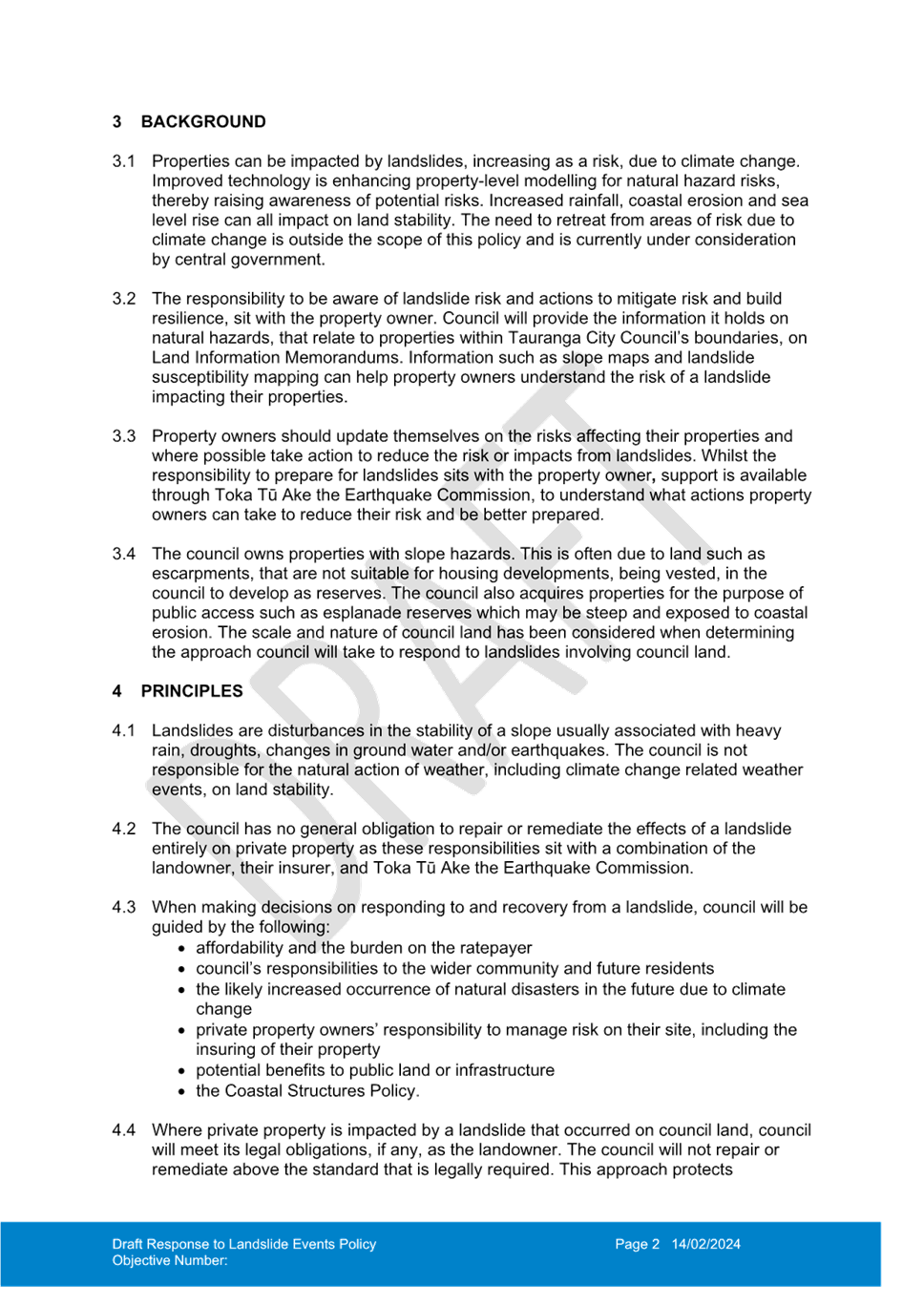
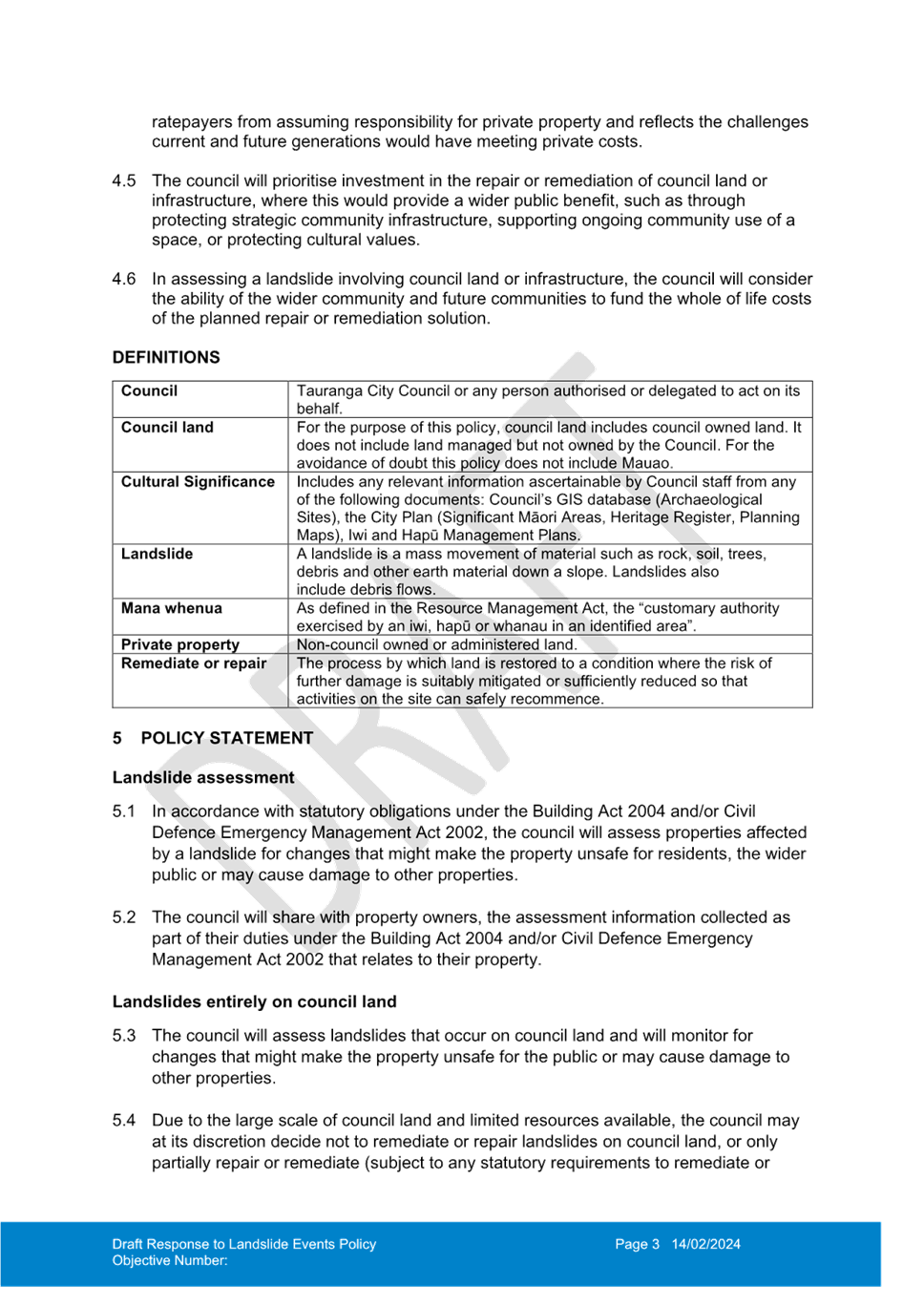


|
Strategy,
Finance and Risk Committee meeting Agenda
|
19
February 2024
|

|
Strategy,
Finance and Risk Committee meeting Agenda
|
19
February 2024
|

|
Strategy,
Finance and Risk Committee meeting Agenda
|
19
February 2024
|





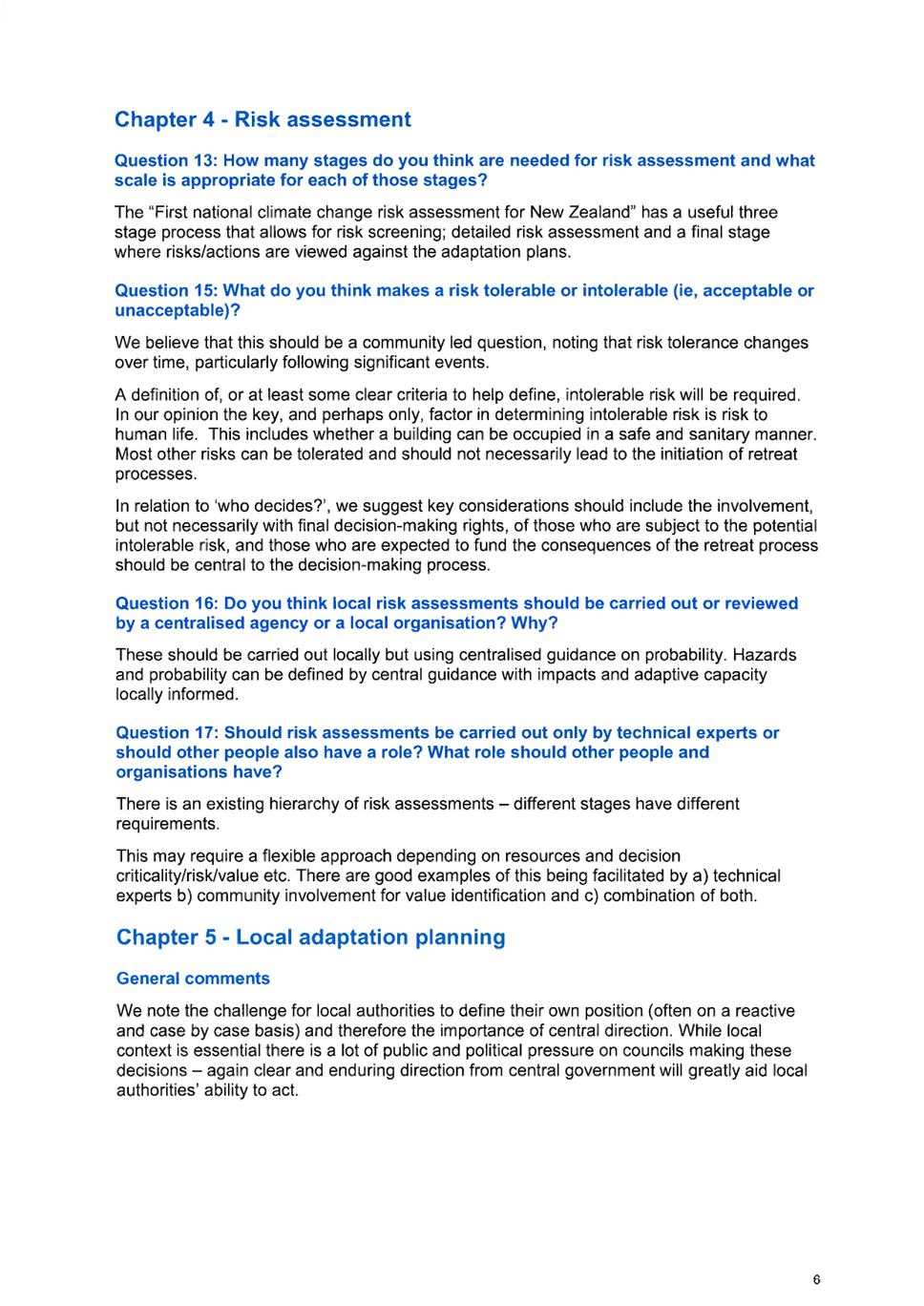
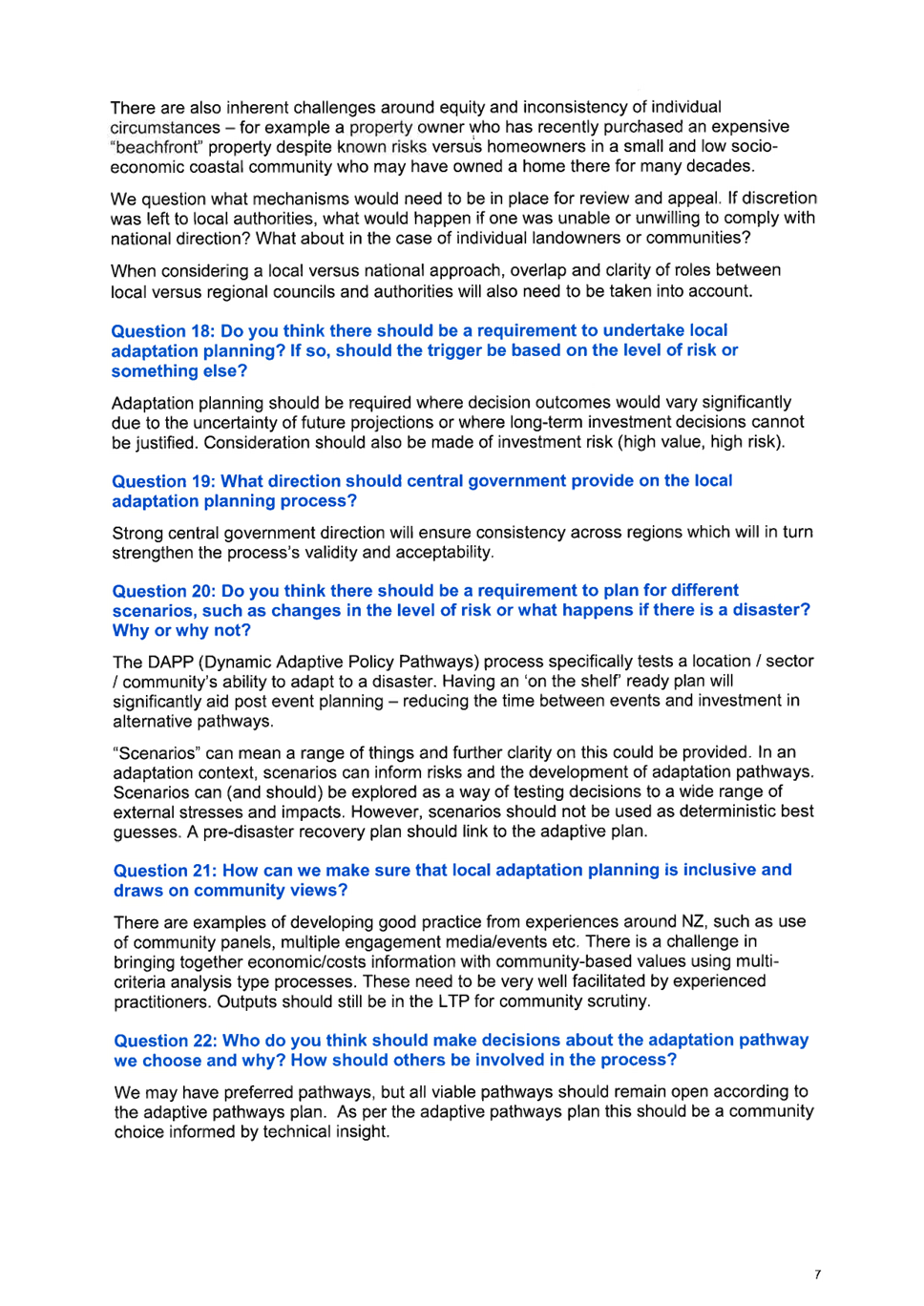
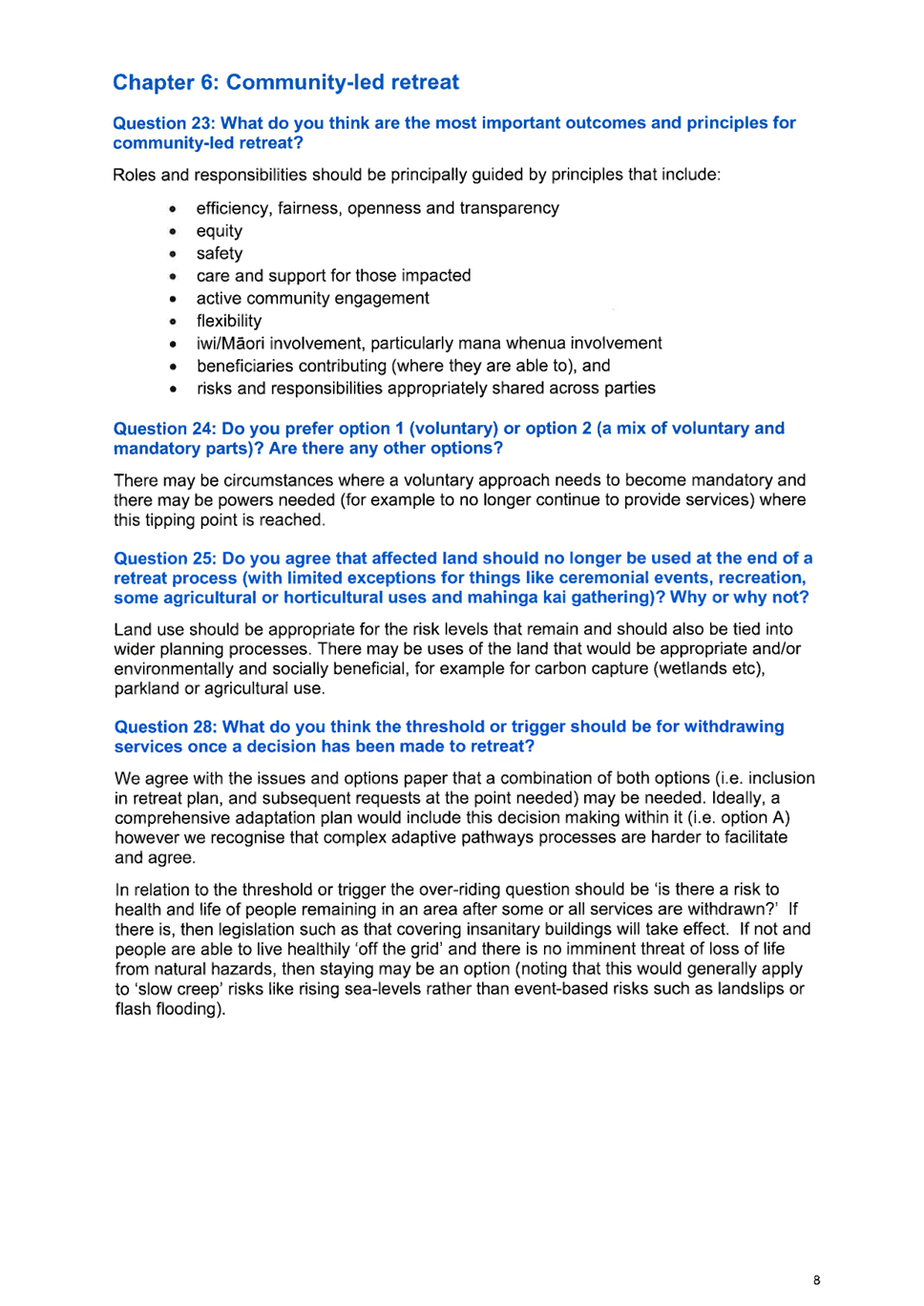
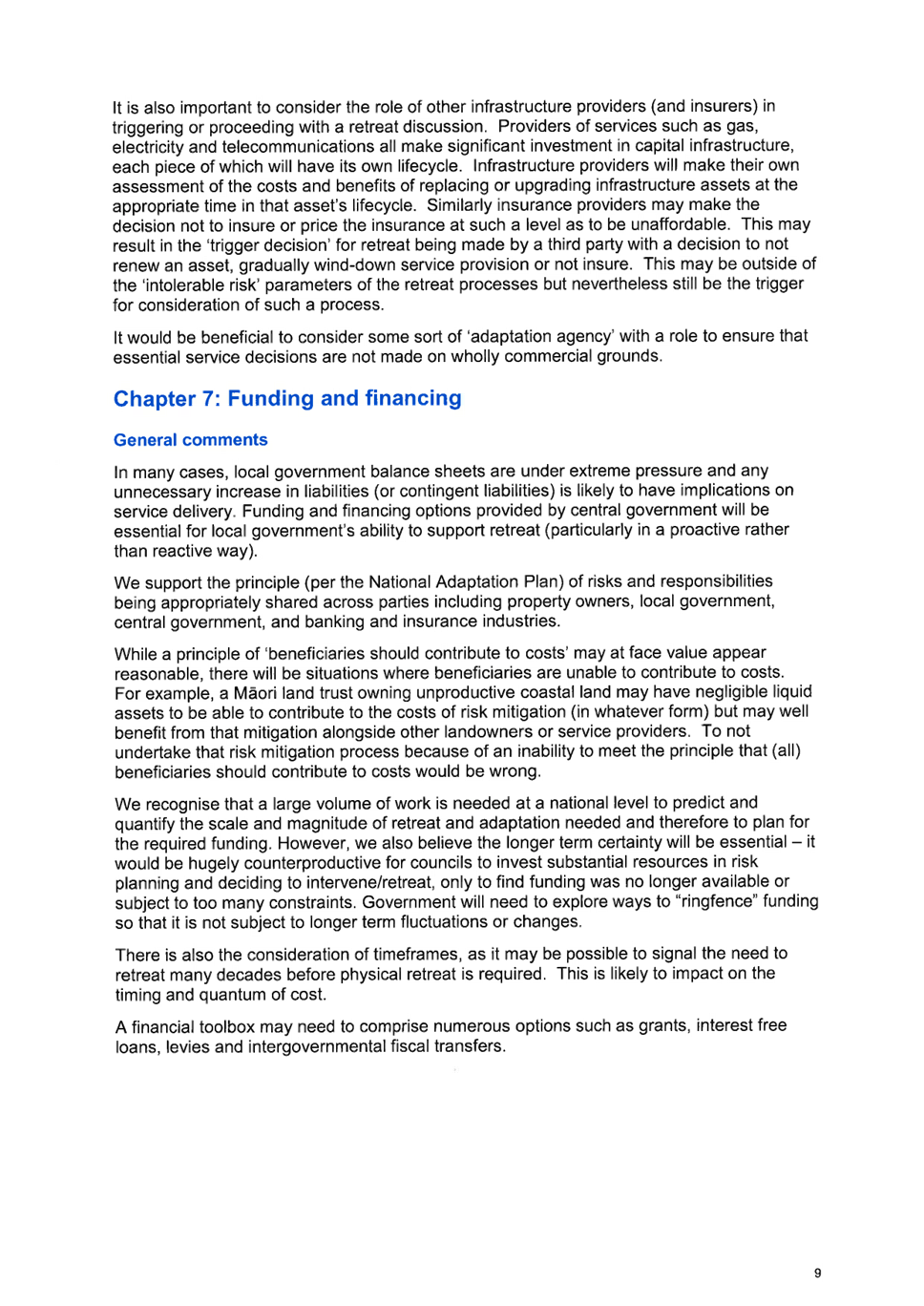
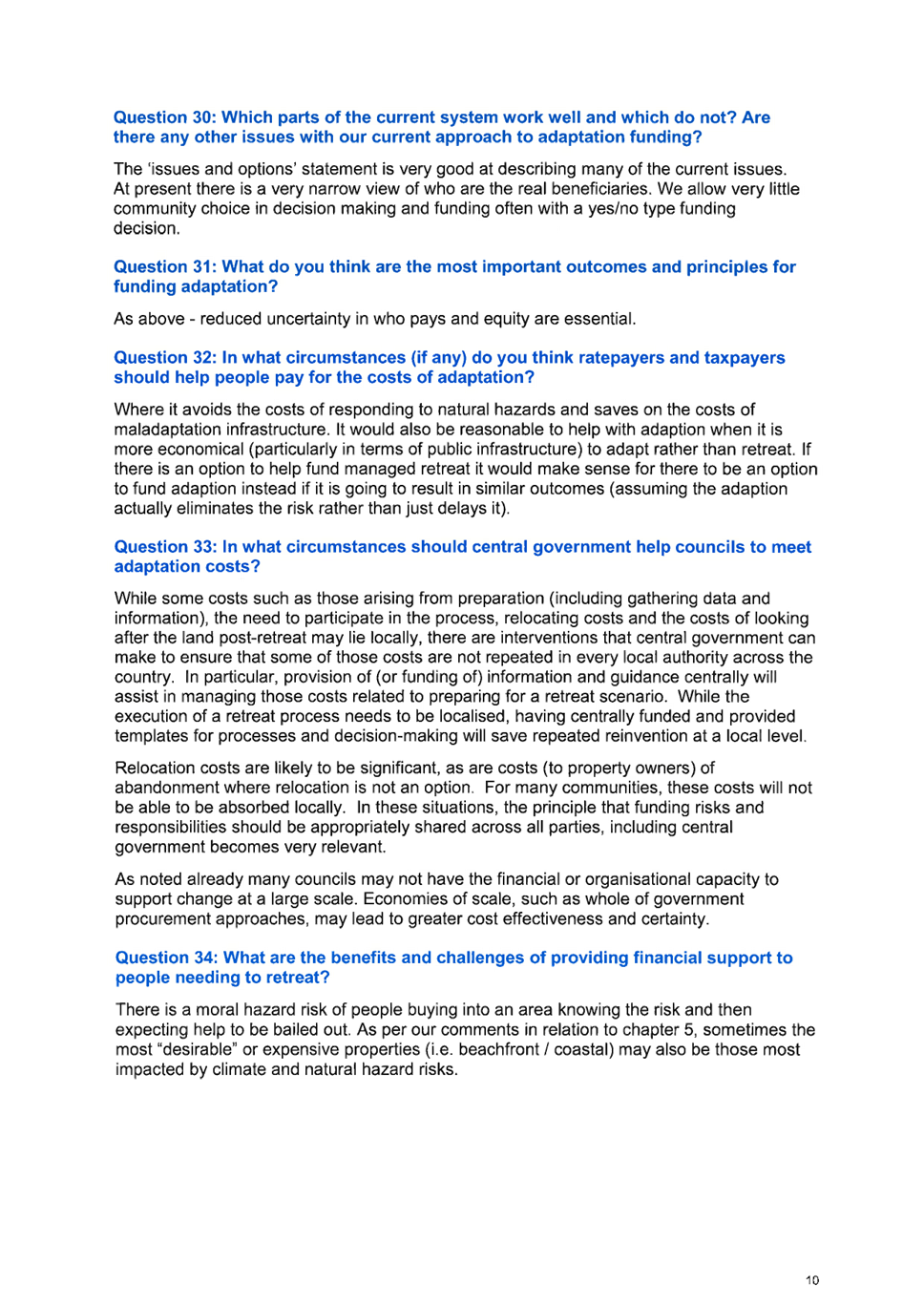
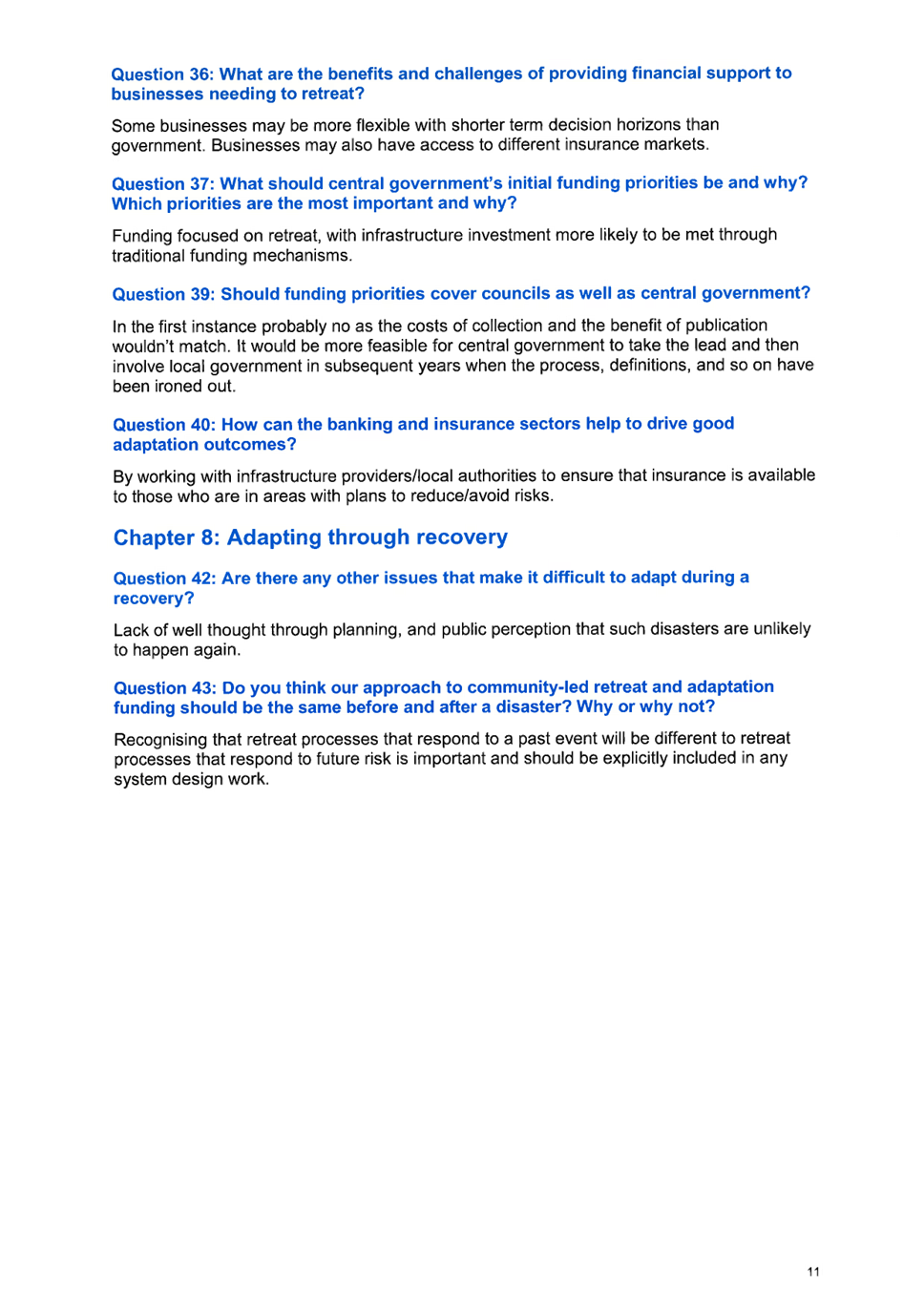
|
Strategy,
Finance and Risk Committee meeting Agenda
|
19
February 2024
|
9.5 Q2
Financial Monitoring Report to 31 December 2023
File
Number: A15355628
Author: Kathryn
Sharplin, Manager: Finance
Tracey Hughes,
Financial Insights & Reporting Manager
Authoriser: Paul
Davidson, Chief Financial Officer
Purpose of the Report
1. The
purpose of this report is to provide information on Council’s financial
performance to 31 December 2023, the second quarter of the 2023/24 financial
year. Revised non-financial performance reporting will be provided in March for
the 6 months to end of December 2023.
|
Recommendations
That the Strategy,
Finance and Risk Committee:
(a) Receives
the report "Q2 Financial Monitoring Report to 31 December 2023".
(b) Recommend
to Council to approve unbudgeted loan-funded operating expenditure and
associated rates-funded debt retirement over a five year period:
(i) $370k
for Keenan Road Business case
(ii) Wairoa
Bridge Cycleway contribution to safety works $1.1m
|
Executive Summary
2. This
report along with the material in Attachment 1 outlines council’s draft
financial performance against budget for the six months to 31 December of the
2023-24 financial year. The Statement of Comprehensive Revenue and Expense
(SOCRE), along with capital reporting and treasury performance are presented
and variances explained in Attachment 1.
3. The
overall operating deficit is $14.1m unfavourable to budget with key drivers
being slower receipt of development contribution revenue and vested assets and year
to date overspends in all categories of expenditure.
4. Capital
Expenditure of $188m was delivered which compares to the year-to-date budget of
$233m, excluding vested assets and projects delivered by third parties.
5. Gross
debt is $1.055bn at 31 December and net debt is $942m with $113m held in bank
balances and term deposits.
6. Full
year forecasts for capital expenditure are currently sitting at $415m, however
this is likely to be revised downwards.
7. Total
operating expenditure will be significantly above budget for the year ($49m)
however most of the overspend is not funded by rates in the current year as it
relies on carried forward funding, loan-funding, and unfunded depreciation.
There is a risk that the overall rates requirement for the year may be $2-$3m
(approximately 1%) above what has been collected based on current forecast, which
would then increase loans. The Executive will continue to monitor and mitigate
this forecast position.
Background
8. This
report is for monitoring and reporting purposes showing Council’s second
quarter financial performance against Annual Plan budgets, the basis for our
annual reporting. For management purposes budgets are adjusted for
carried forward expenditure and associated funding from the prior year. These
adjustments are not reflected in the attached reports however may be mentioned
in the commentary.
Discussion
Part 1: Financial Performance
9. The
financial results to 31 December 2023, which is the second quarter of the
2023-24 year are provided as Attachment 1 to this report.
10. Forecasts
have been reviewed, indicating that an increase in the operating deficit of
$42.2m is expected. Forecasts include the impacts of items carried forward from
the prior year as well as updated expectations.
11. The overall
operating deficit is $14.1m unfavourable to budget. There are a number of
variances that relate to timing of revenue or expenditure.
Expenditure
(a) Depreciation
is $5.7m over budget year to date, and is expected to be $11.5m over budget for
the full year. Depreciation is now reporting as calculated through the fixed
assets register and includes all impacts of revaluation and capitalisation from
2023. The 2023 revaluations were finalised after the 2024 Annual Plan adoption,
and as the waters revaluation in particular was very significant, this has had
a similarly significant impact on depreciation, over budget. The additional
depreciation will not be funded in the current year. This will also impact the
LTP 2024-34 currently being prepared, and our approach and assumptions for the
funding of depreciation may need to be reviewed.
(b) Personnel
costs are $2.8m over budget currently and are forecast to be $3.1m over budget
for the full year. This will generate a negative impact on rates requirement of
$1-$2m for the year. This will partly be offset by some higher revenue.
Capitalisation is currently on budget although further analysis is required to
ensure that our reporting of Digital projects is being reflected correctly. The
year to date salaries overspend is widely spread over the organisation and we
expect that some of these overspends will reduce in January as leave is taken.
Salary savings are not being realised as replacements are employed quicker than
anticipated. The impacts of restructures are also expected to affect the full
year position. Further analysis to more clearly understand the drivers of this
variance will be undertaken.
(c) Finance costs
are $3.2m over budget resulting from higher opening balances and higher rates
than had been anticipated in the annual plan. This is currently substantially
offset by finance revenue ($3m over budget year to date), for the same reasons.
The forecast for finance costs net of revenue is projected to be $4m over
budget for the year, impacted by elevated interest rates and the increase
reflected in the forecast capital programme. This would generate an additional
rates requirement of approximately $2m. If the current Capital forecast is not
achieved, the overspend in interest for the year will be reduced.
(d) Other
expenditure is currently $12.6m over budget and forecast to be $28.4m over
budget for the full year. Overall however, this will have little impact on
rates funding. A significant proportion of both year to date expenditure
and forecast is related to items initially budgeted and funded in the
2023 financial year and brought forward ($9.3m full year), mainly in the
community contributions and grants area. Items that are or are likely to become
loan-funded ($18.7m full year) such as Tauriko West (timing adjustments), and
business case development and software development charges (budgeted as
capital) also contribute to this overspend. More detailed information on how
expenditure is tracking by activity can be seen in Attachment 1. An item
to note that is significantly above budget is insurance costs. We have added
large uplifts to the insurance budget every year reflecting both the higher
value of the asset base and higher insurance charges, however actual
expenditure continues to come in over budget as costs continue to increase. The
forecast for the full year is $600k over the $5.5m budget.
Revenue
(e) Metered water
revenue is tracking slightly ahead of budget for the half year. Quarter one
results were slightly behind budget, the difference being a catch up in volumes
due to the warmer weather and adjustments to accruals. Full year revenue is
expected to be on budget. Please see Attachment 2 for background
information on water volume modelling.
(f) Subsidies
and grants are ahead of budget for the year. The full year forecast of
subsidy revenue has been revised upward following Waka Kotahi agreement to fund
the increase in maintenance and renewal work budgeted for the year but not
initially included in the year’s funding agreements. Subsidies and grants
relating to capital projects carried forward from 2023 are included in this
revision. Offsetting this forecast increase, the annual plan did include a
government subsidy of council’s ongoing water reform costs.
However, this work slowed in quarter two and the full year subsidy is now
expected to be less than budgeted. Updates on timing of expected Tauriko West
IFF subsidies has also reduced the forecast. As a result of these impacts the
full year subsidy revenue forecast has been decreased by $5m, across capital
and operational subsidies.
(g) Fees and
Charges are above budget for the first six months with about $900,000 in the
recognition of revenue recorded as pre-receipts at year end. Above budget
revenue areas are parking, Baycourt and wastewater. The forecast for the year
has been increased by $3m.
(h) Growth-related
revenue including development contributions and vested assets are below
budget. Revenue is recognised as building and subdivisions occur or as
developers complete and vest assets to council. Full year forecast for
development contributions has been reduced by $7.5m reflecting reduced volumes
of new dwelling consents.
12. Capital
expenditure of $188m was delivered which compares to the year-to-date budget of
$233m, excluding vested assets and projects delivered by third parties. The
full year forecast has been revised to $415.3m, which is $36m below the revised
baseline budget (which includes carry forwards from 2023). The main
variances driving this forecast are:
(a) delayed
Cameron Road Stage 2 programme – a business case is underway but
construction of Stage 2 is unlikely to commence this financial year
(b) delayed Te
Maunga Transfer Station Redevelopment while a business case is developed and
funding assumptions considered
(c) changes
to the accounting treatment for Digital projects, resulting in reduced capital
and increased operational budgets
13. The Treasury
report shows Gross debt at $1.055bn and net debt at $942m. Money market
investments and bank deposits are at $105m. Interest rate hedging and
debt maturity profiles remain within Treasury policy. While interest
rates remain relatively high, with the OCR at 5.5%, council’s average
borrowing rate including margins is at 4.76%. A new record for monthly cash
payments was reached in November of $75m, reflecting both inflation and the
increase in business activity.
Transport requests
for loan funding
14. Keenan Road
business case - $370k is requested as TCC share of this business case. The
substantive project has been delayed in the LTP 2024-34 however the business
case work has already been started and will be used to inform future planning
decisions. The request to loan-fund reflects the expectation of realising the
benefits over time. The loan will be repaid over 5 years.
15. Wairoa bridge
Cycleway - $1.1m is requested as TCC share of project costs. Capital funding
for this has previously been agreed in order to address immediate safety risks,
however in the short-term the asset will not belong to TCC, necessitating
treatment as operating expenditure. The loan will be repaid over 5 years.
Finance
Dashboard
16. The Finance
and Digital teams have been working together to provide at-a-glance financial
information for Exec and Activity Managers. The dashboard development has
completed phase 1 and is available through the TCC Intranet. We are
investigating how to make this available live online for commissioners as well.
Further development is programmed, with the intention of making this a one-stop
financial data shop for most of the business. Some high level screen shots are
included in Attachment 3.
Options
Analysis
17. There
are no options associated with this report. The report is provided as
information only.
Financial
Considerations
18. This
report monitors performance to budget to ensure council delivers on proposed
expenditure within allocated budgets to ensure financial sustainability and
accountability.
Strategic
/ Statutory Context
19. Maintaining expenditure within annual plan budget ensures delivery
of services in a financially sustainable way. Variance review assists in
identifying risks and trends facing council
Legal
Implications / Risks
20. This
monitoring report has no specific legal implications or risks.
Consultation
/ Engagement
21. This
report is made public.
Significance
22. The
Local Government Act 2002 requires an assessment of the significance of
matters, issues, proposals and decisions in this report against Council’s
Significance and Engagement Policy. Council acknowledges that in some
instances a matter, issue, proposal or decision may have a high degree of
importance to individuals, groups, or agencies affected by the report.
23. In
making this assessment, consideration has been given to the likely impact, and
likely consequences for:
(a) the current
and future social, economic, environmental, or cultural well-being of the
district or region
(b) any persons who are likely to be
particularly affected by, or interested in, the matter.
(c) the capacity of the local authority to
perform its role, and the financial and other costs of doing so.
24. In
accordance with the considerations above, criteria and thresholds in the
policy, it is considered that the matter is of low significance.
ENGAGEMENT
25. Taking
into consideration the above assessment, that the matter is of low significance,
officers are of the opinion that no further engagement is required prior to
Council making a decision.
Next
Steps
26. This report ensures monitoring of Council performance to ensure
compliance with Council’s budgets, policies and delegations. The
non-financial monitoring report summary will be presented on the Council
website.
Attachments
1. Opex,
capex and treasury reports - A15465580 ⇩ 
2. Water
volumes modelling - A15466087 ⇩ 
3. BI Report -
trends - A15489952 ⇩ 
|
Strategy,
Finance and Risk Committee meeting Agenda
|
19
February 2024
|
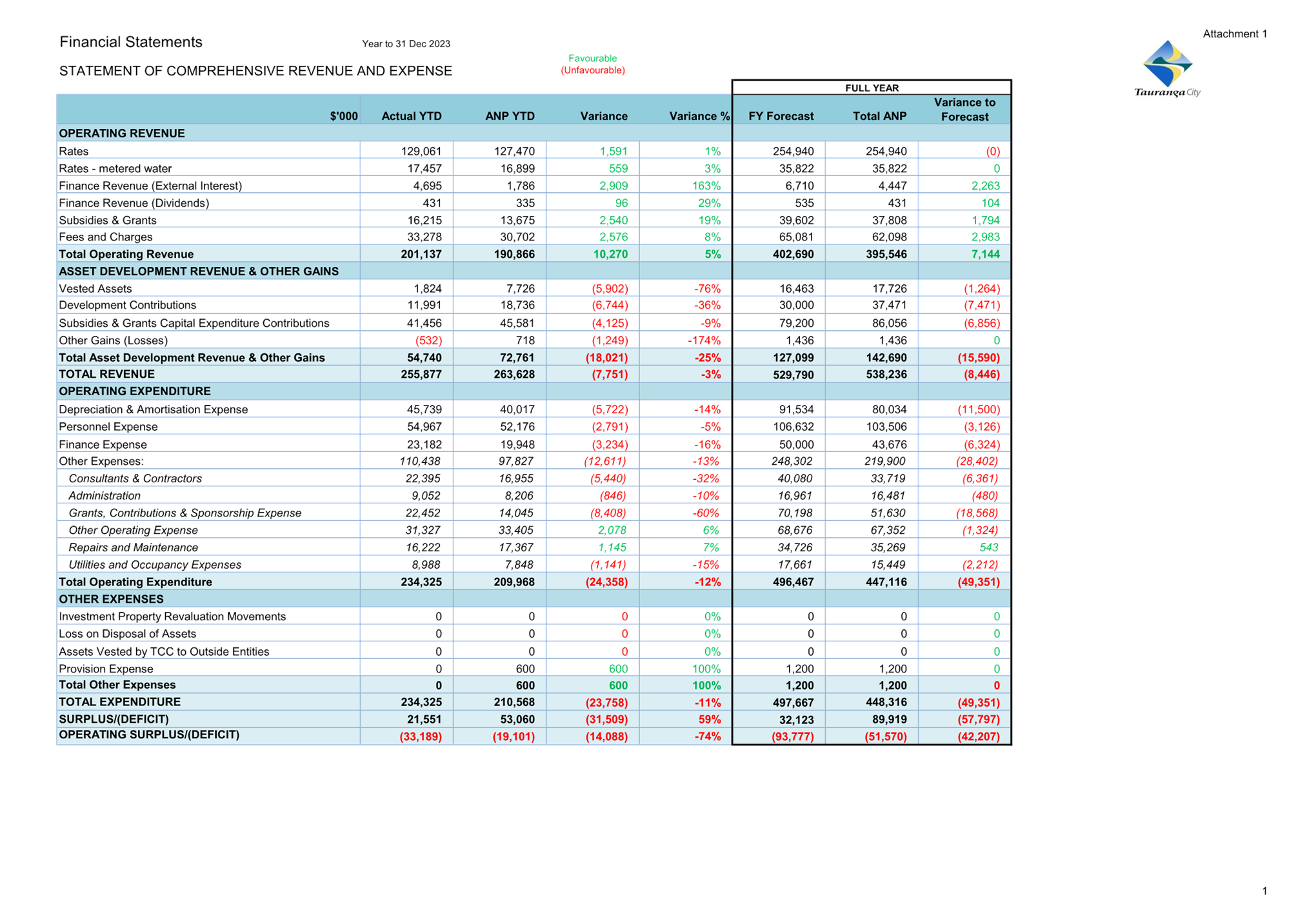

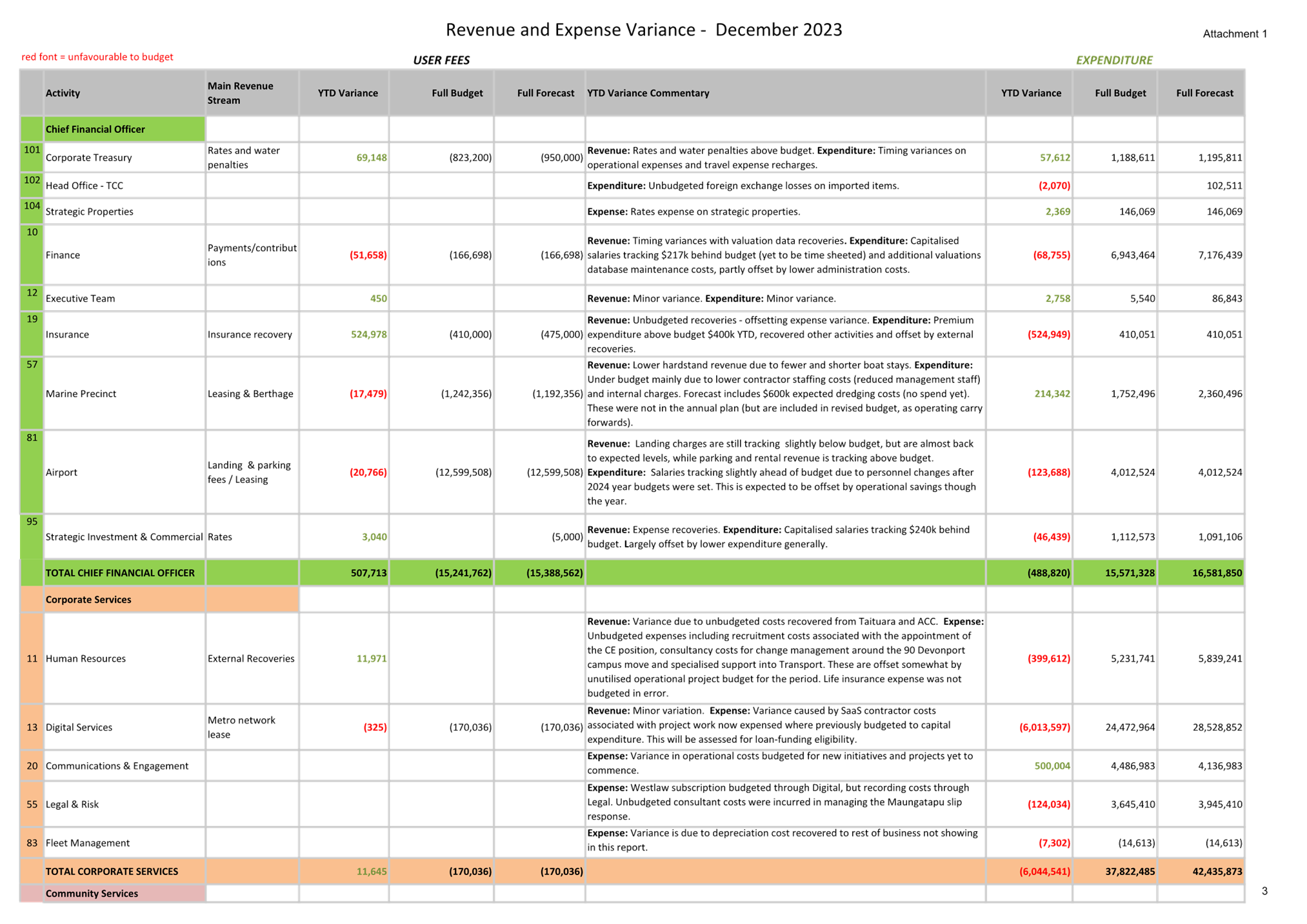
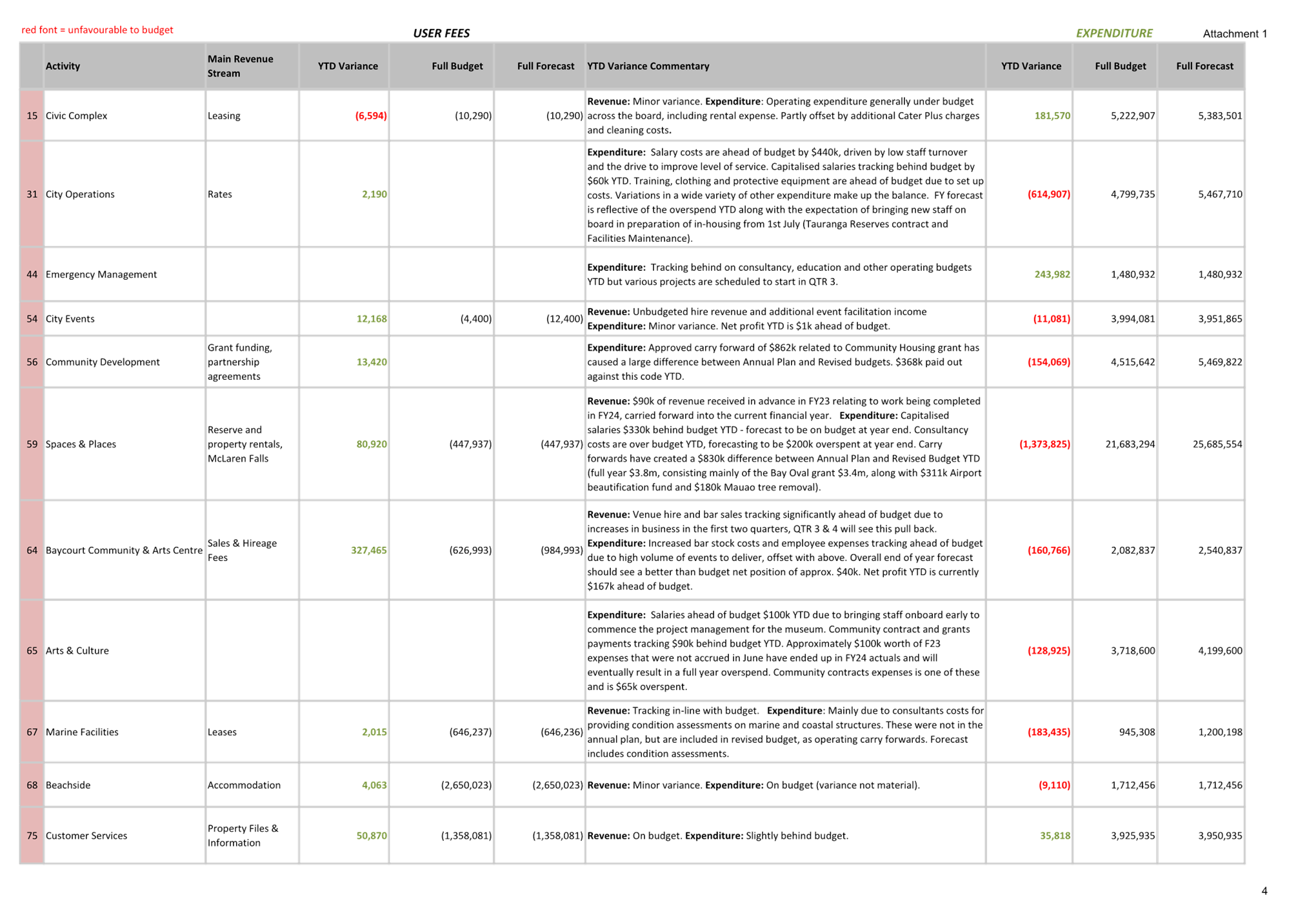
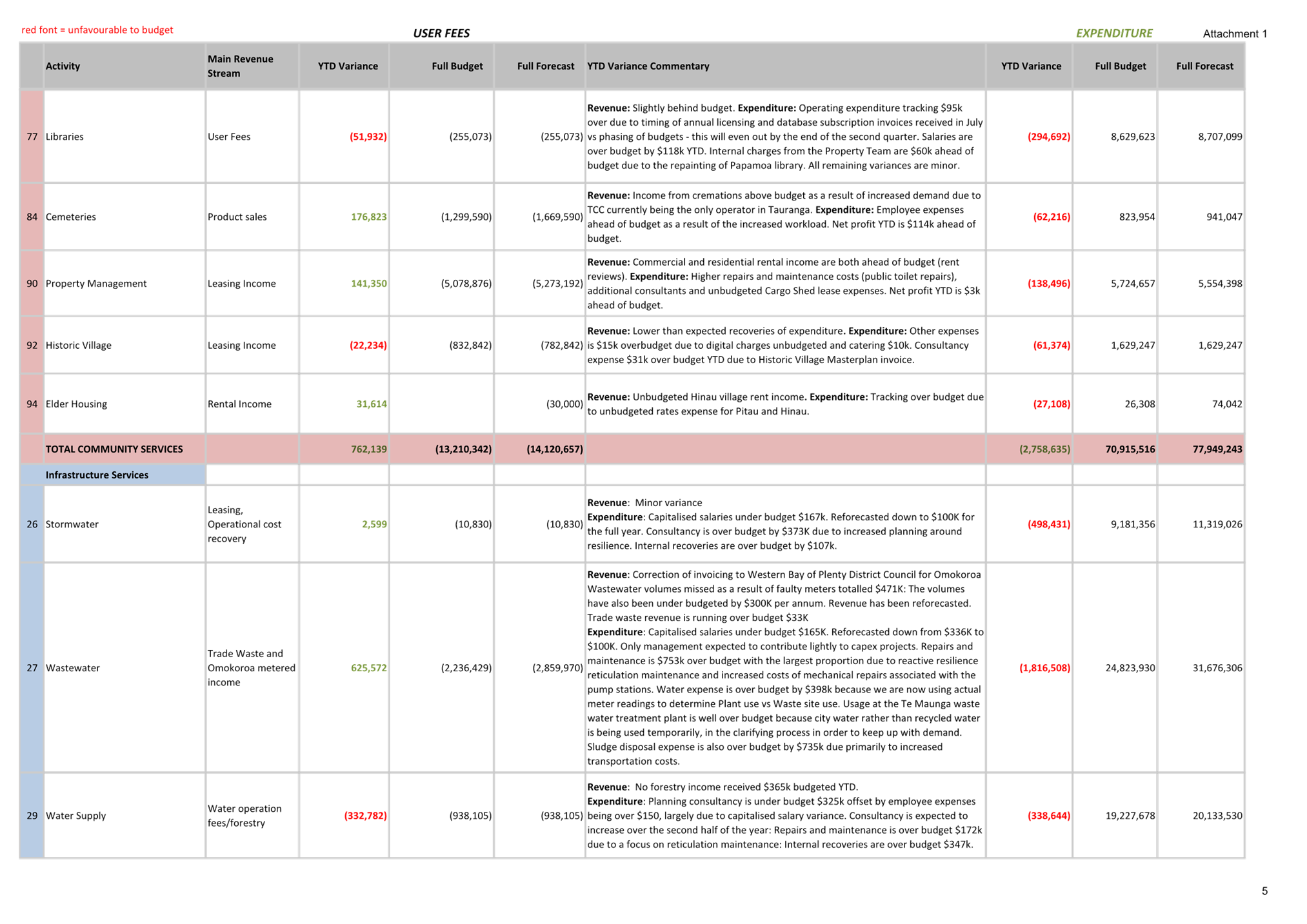
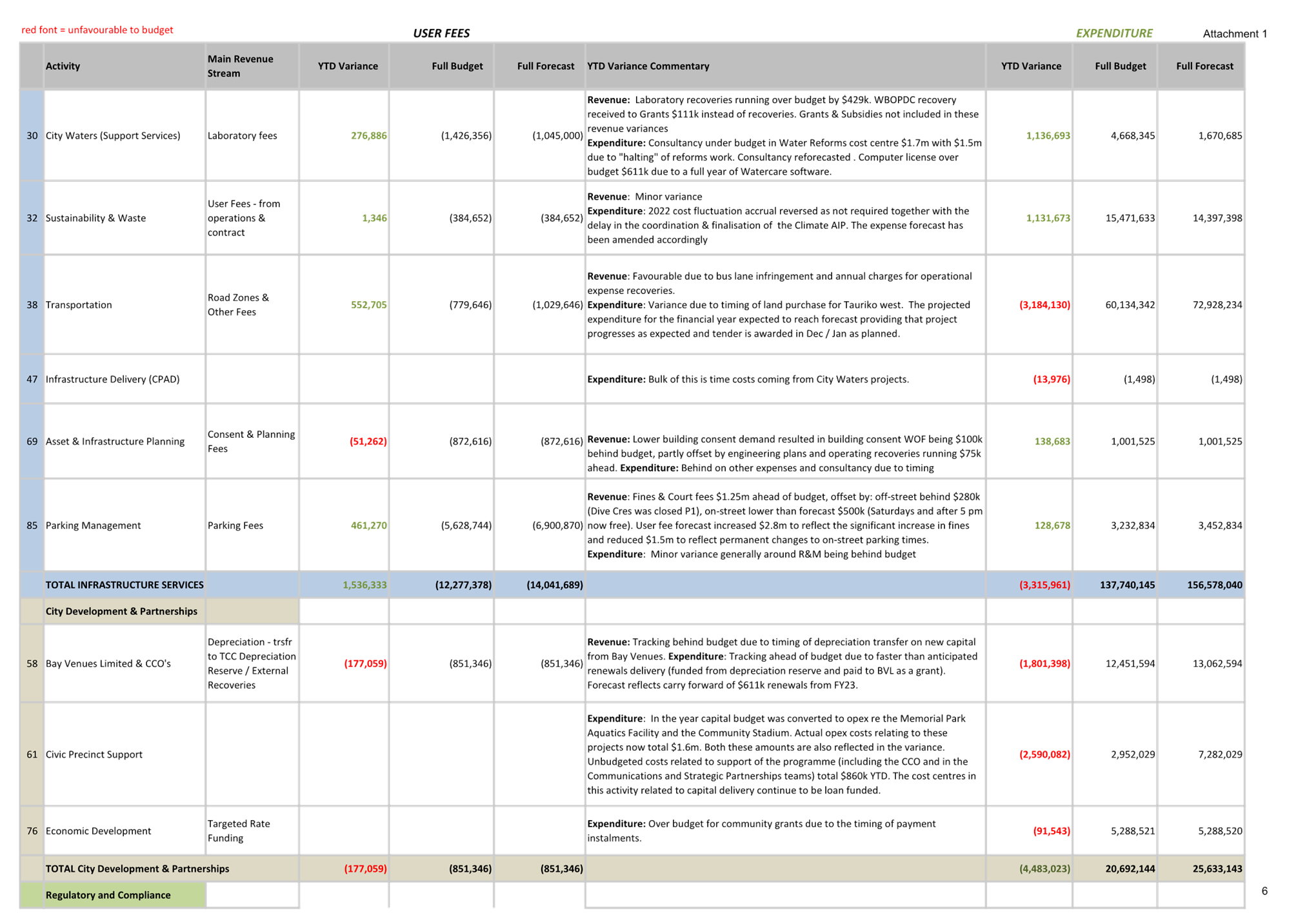
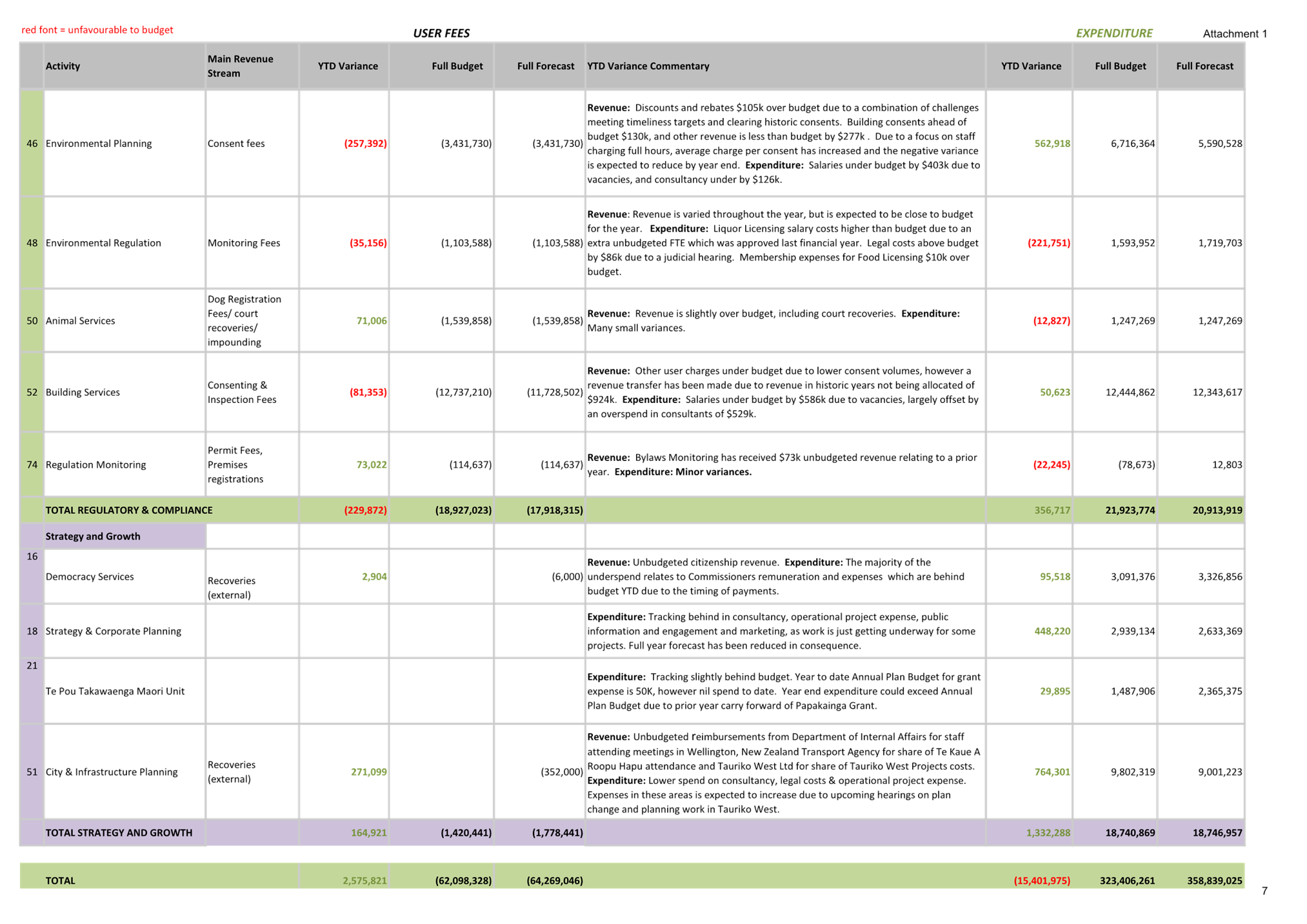

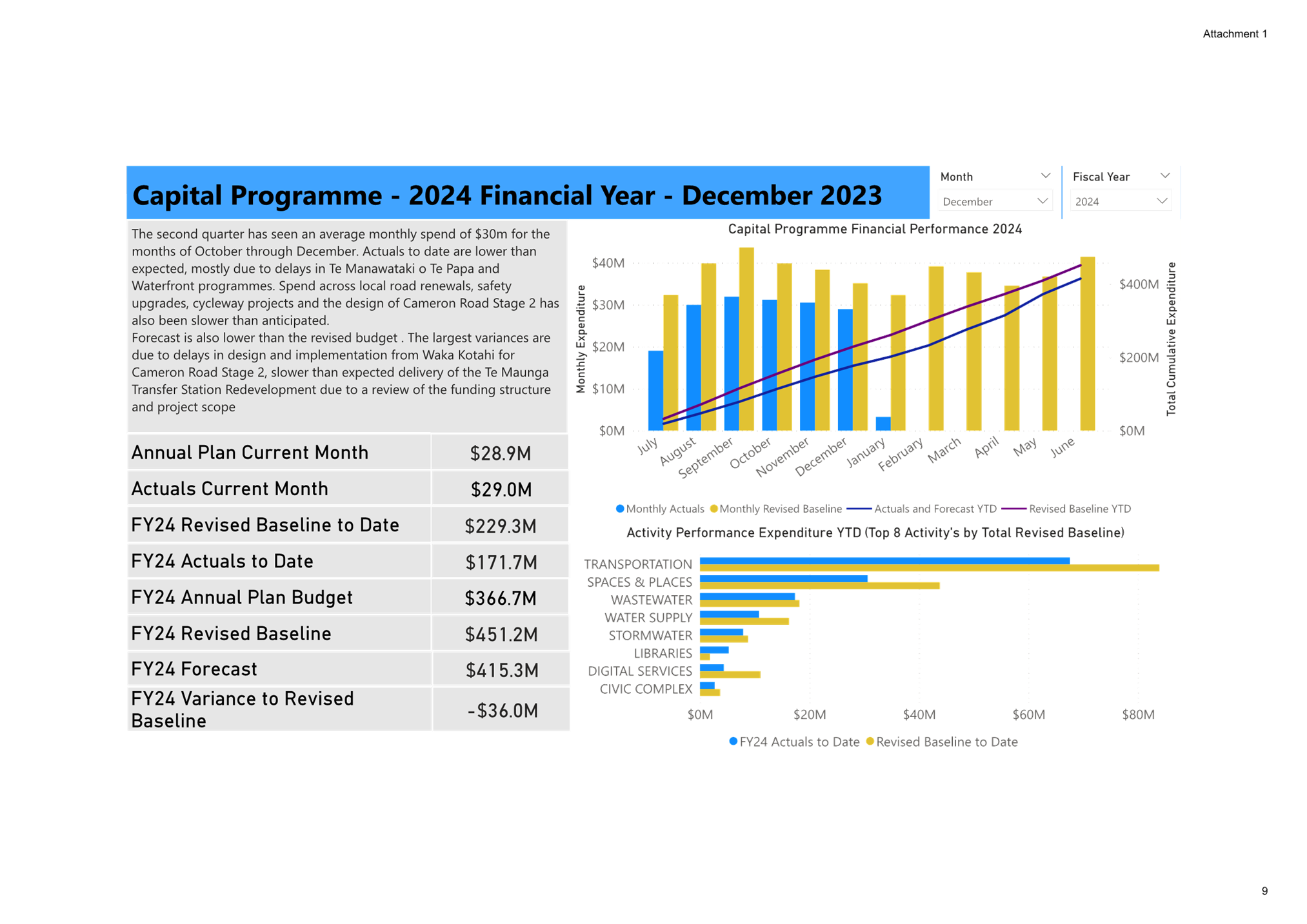
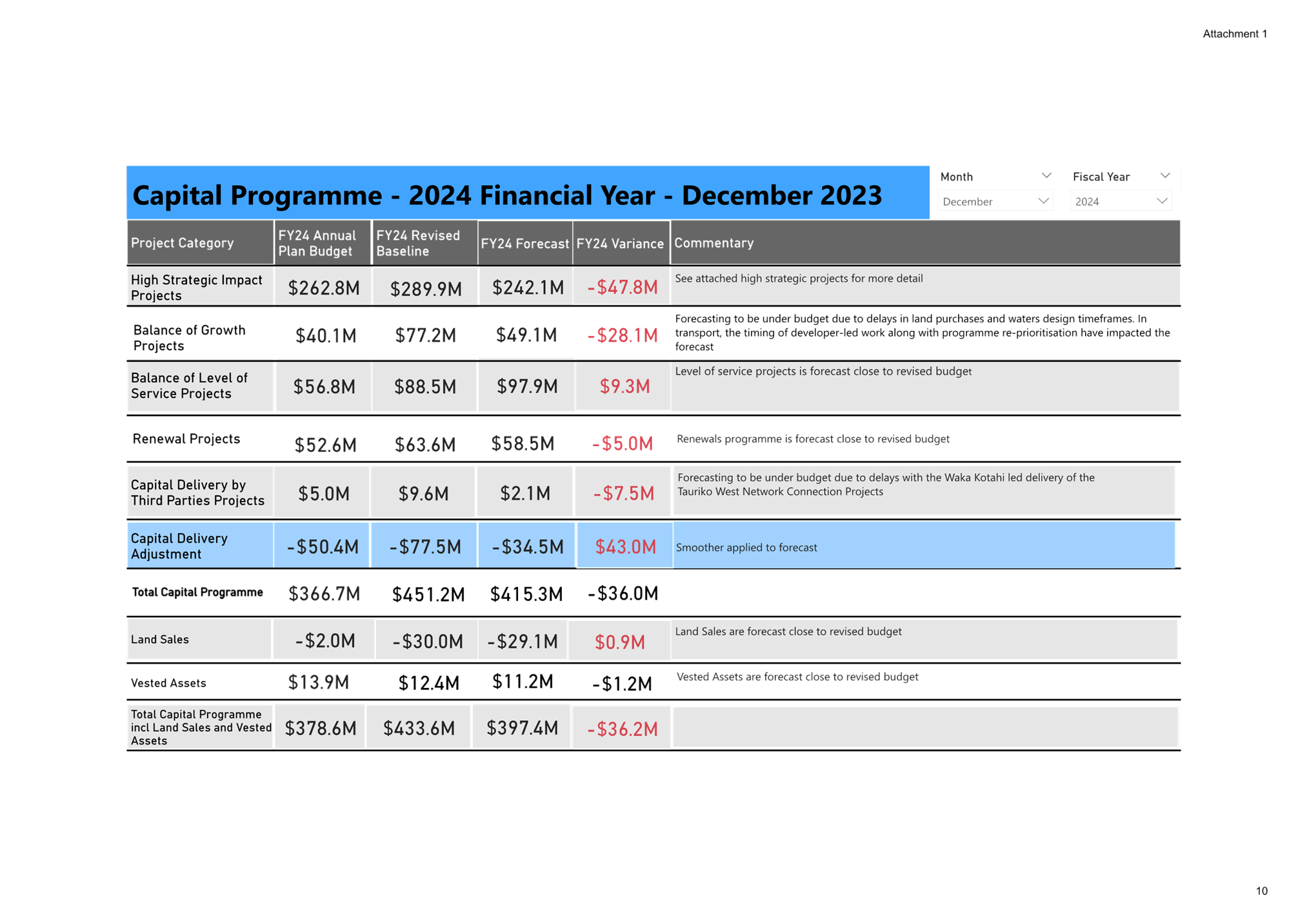
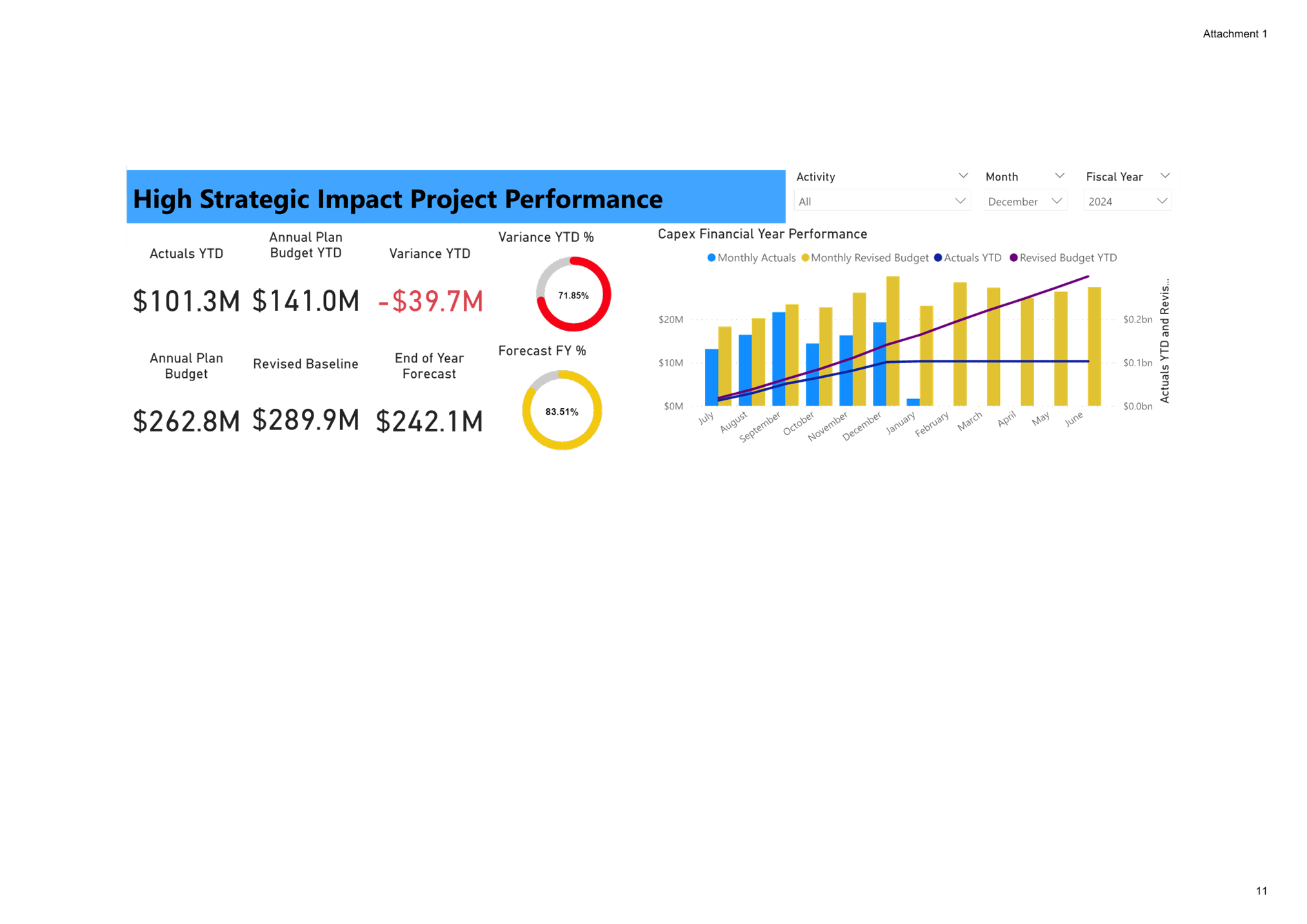
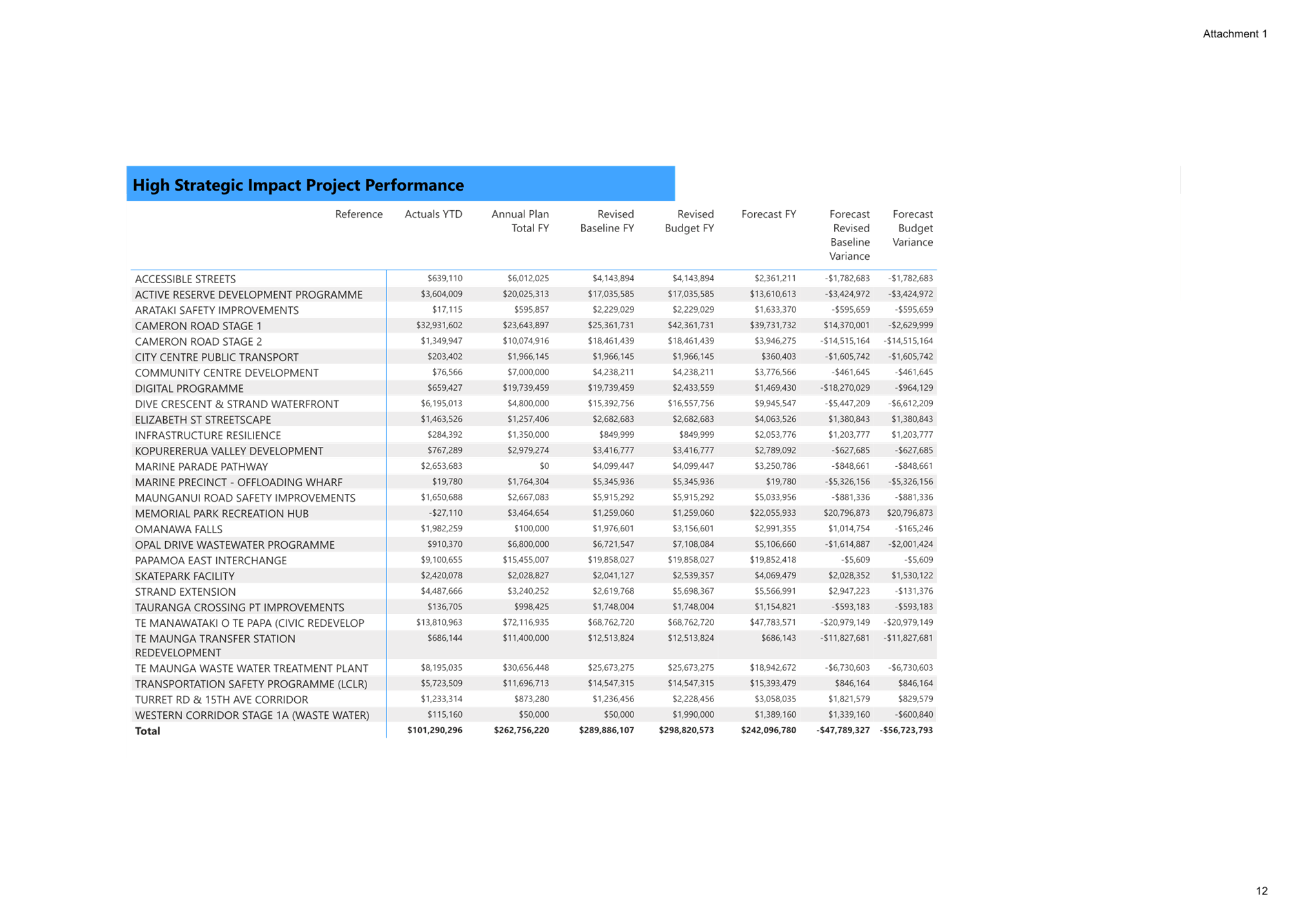
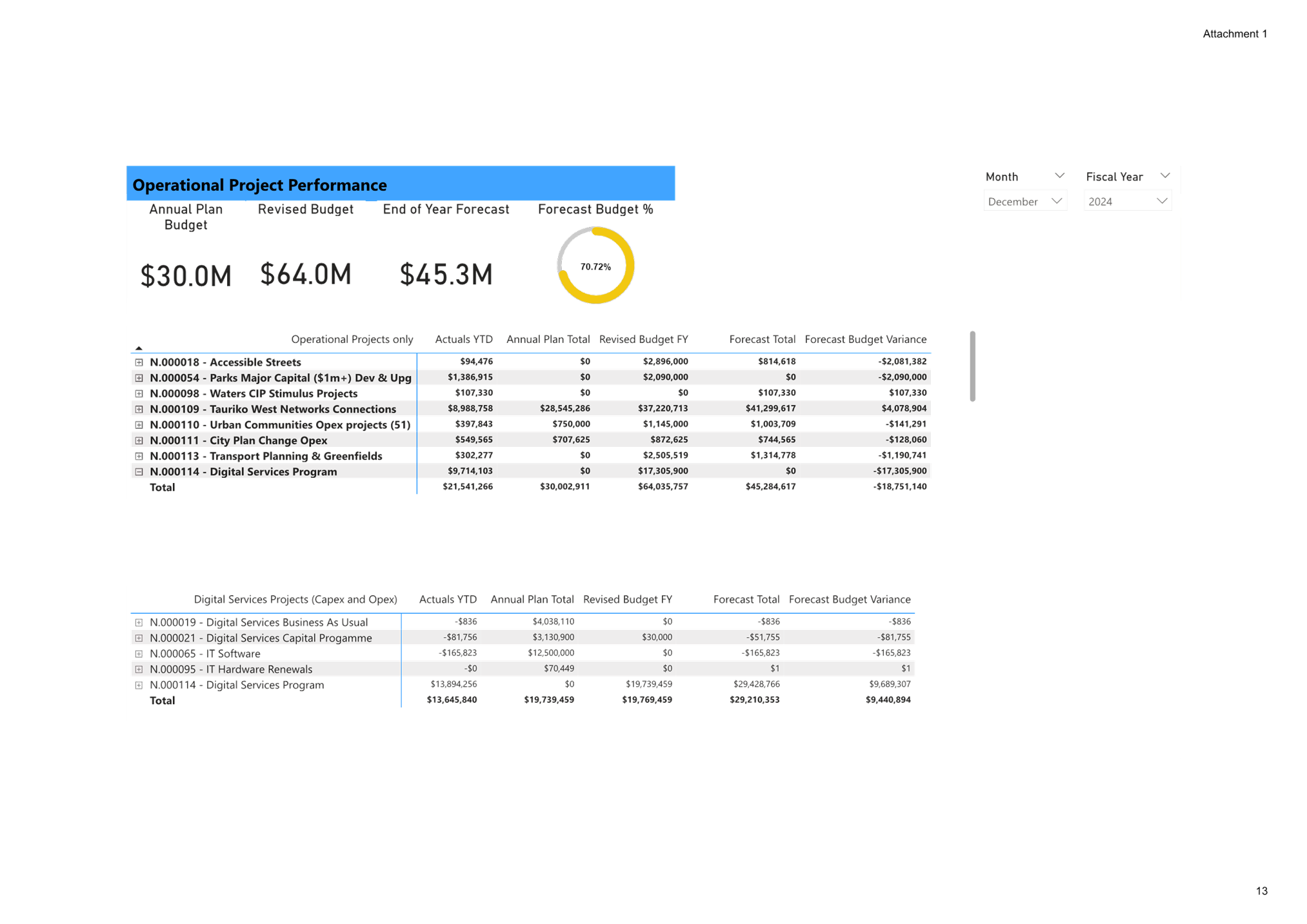
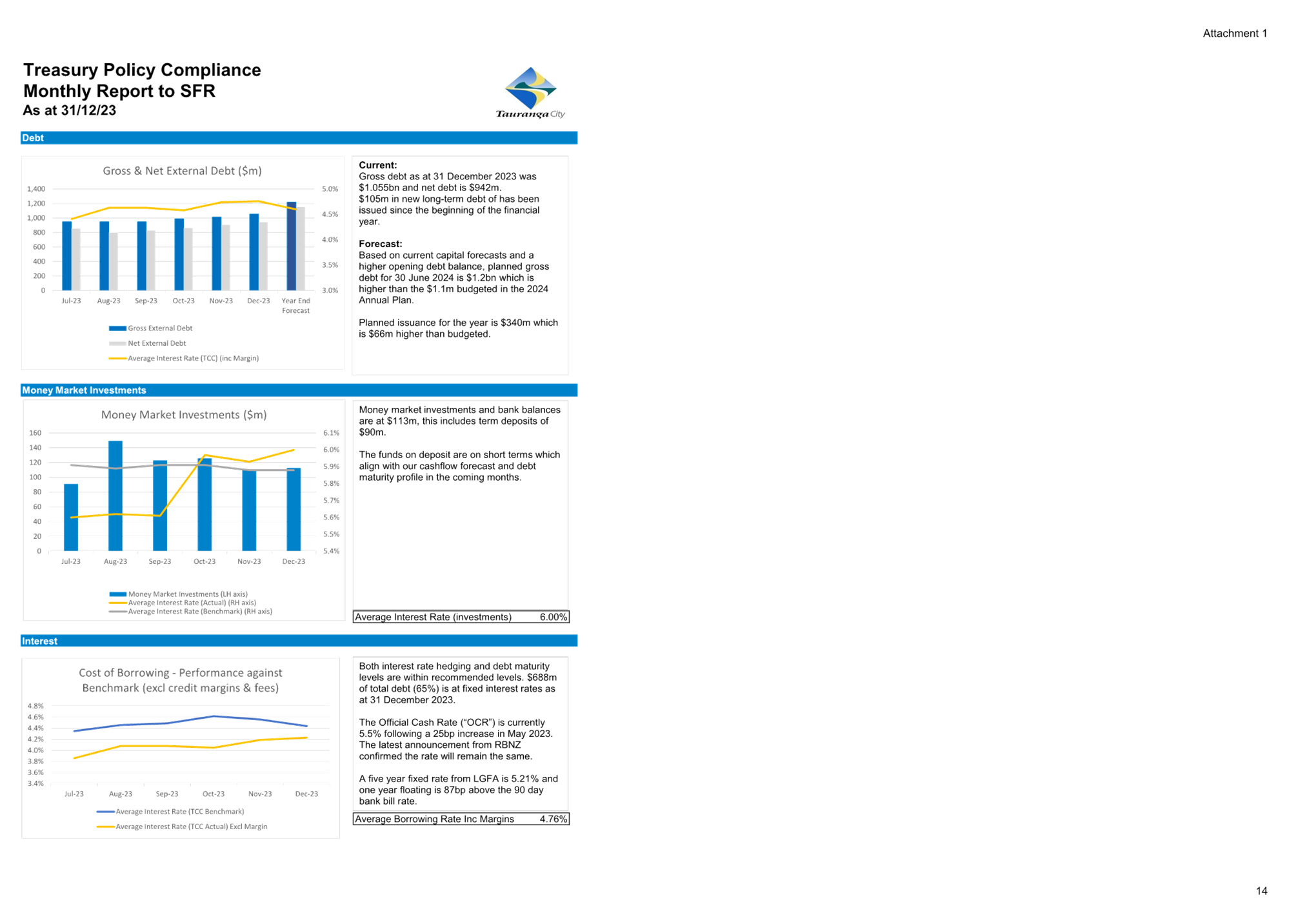
|
Strategy,
Finance and Risk Committee meeting Agenda
|
19
February 2024
|
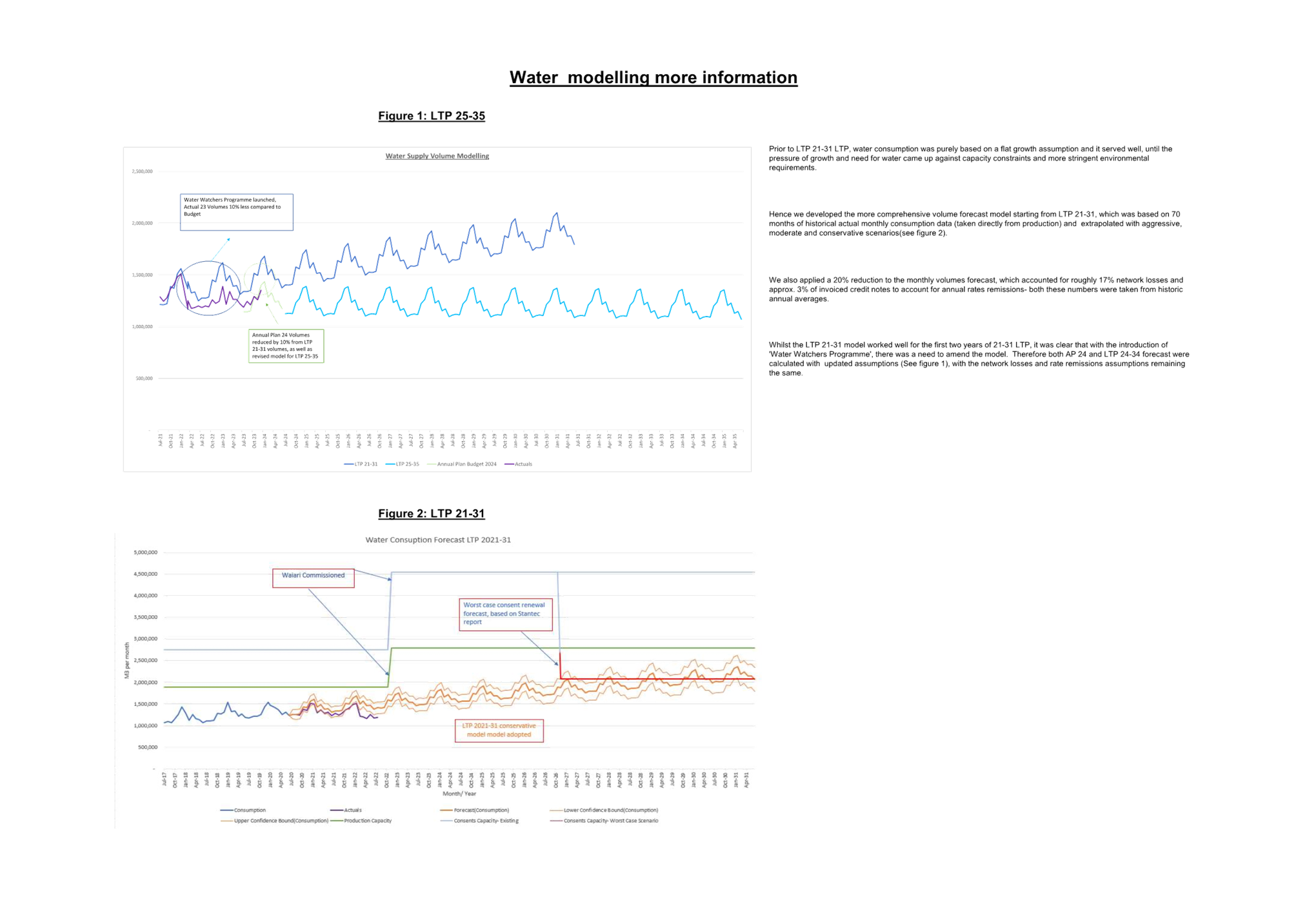
|
Strategy,
Finance and Risk Committee meeting Agenda
|
19
February 2024
|
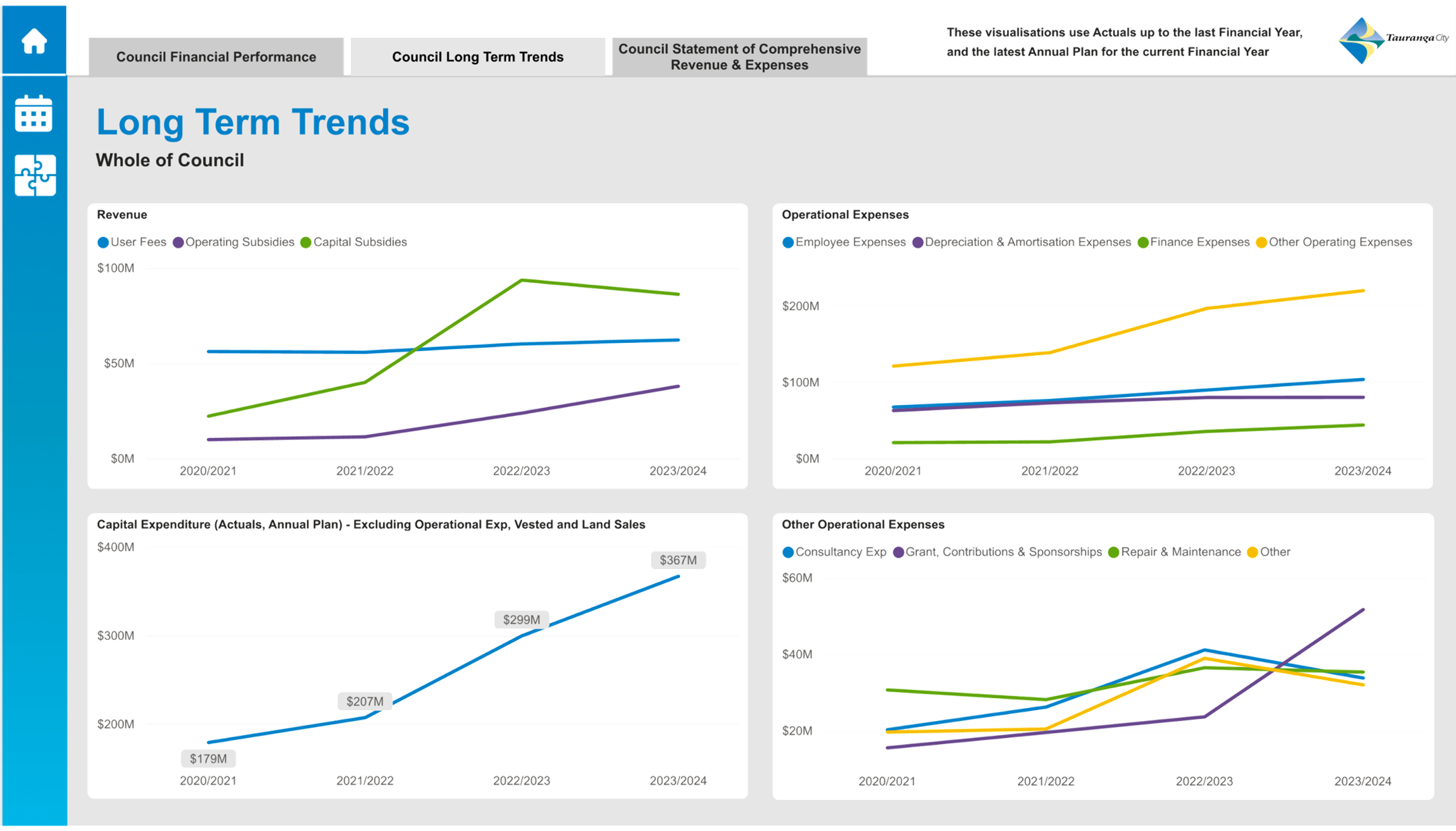
9.6 Capital
Programme 2023/24 6 month update – James Woodward
Attachments
Nil
|
Strategy,
Finance and Risk Committee meeting Agenda
|
19
February 2024
|
9.7 LGOIMA
and Privacy Report Q2 for 2023/2024 year
File
Number: A15492382
Author: Darelle
Howard, Administrator: Democracy Services
Authoriser: Christine
Jones, General Manager: Strategy, Growth & Governance
Purpose of the Report
1. The purpose of this report is to update the Committee on
Local Government Official Information and Meetings Act 1987 (LGOIMA) and
Privacy requests for the second quarter of 2023/24
|
Recommendations
That the Strategy,
Finance and Risk Committee:
(a) Receives the report
“LGOIMA and Privacy Report Q2 for 2023/2024 year.
|
Executive Summary
2. These reports are
provided to the Committee to provide assurance on statutory compliance for
LGOIMA and Privacy requests.
Attachments
1. Q2
Report LGOIMA and Privacy requests - Oct-Dec 2023 - A15492304 ⇩ 
|
Strategy,
Finance and Risk Committee meeting Agenda
|
19
February 2024
|
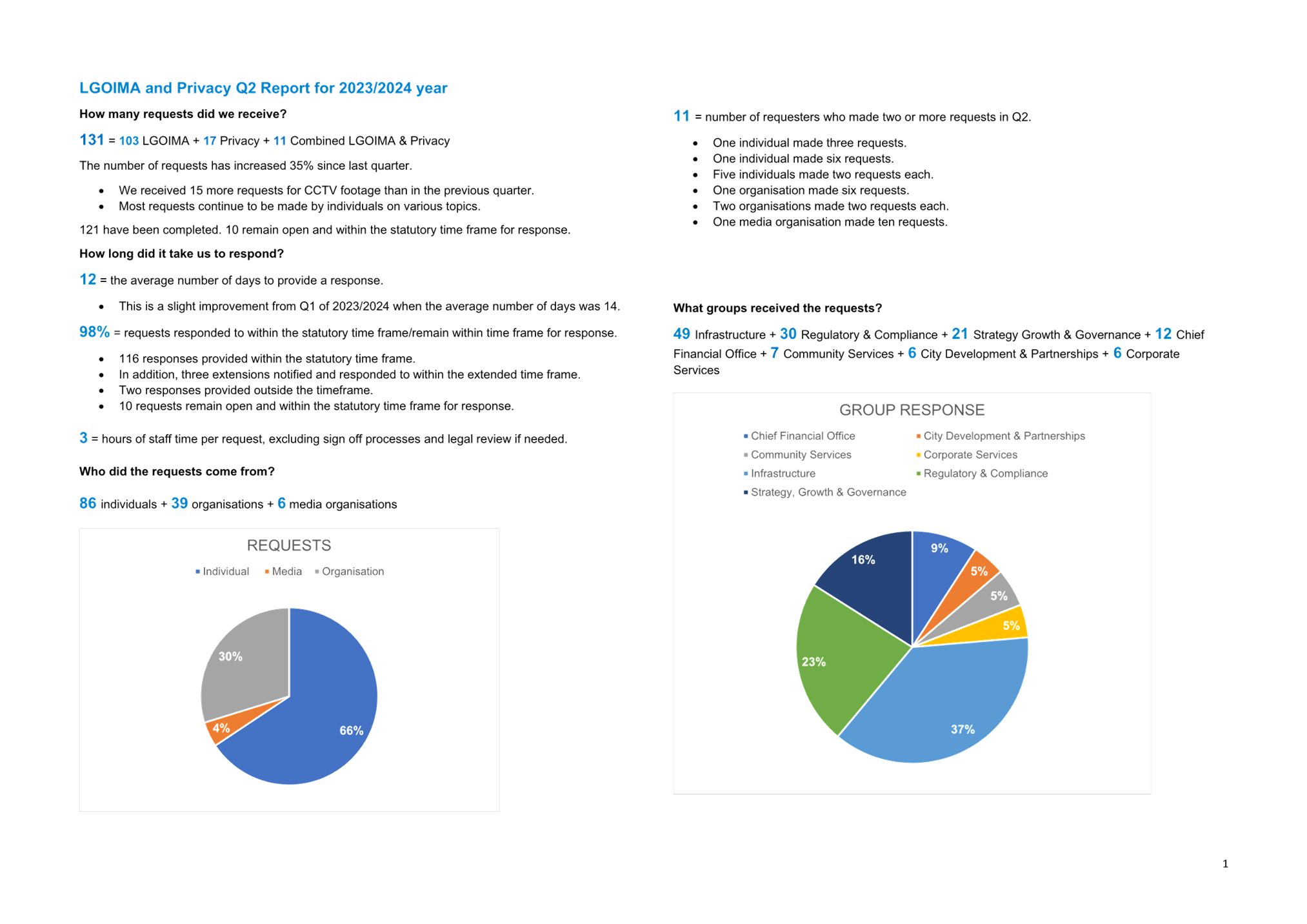

|
Strategy,
Finance and Risk Committee meeting Agenda
|
19
February 2024
|
11 Public
excluded session
Resolution to exclude
the public
|
Recommendations
That the public be
excluded from the following parts of the proceedings of this meeting.
The general subject
matter of each matter to be considered while the public is excluded, the
reason for passing this resolution in relation to each matter, and the
specific grounds under section 48 of the Local Government Official
Information and Meetings Act 1987 for the passing of this resolution are as
follows:
|
General subject of each matter to be
considered
|
Reason for passing this resolution in
relation to each matter
|
Ground(s) under section 48 for the
passing of this resolution
|
|
11.1 - Public Excluded Minutes of the
Strategy, Finance and Risk Committee meeting held on 4 December 2023
|
s7(2)(a) - The withholding of the information is
necessary to protect the privacy of natural persons, including that of
deceased natural persons
s7(2)(b)(i) - The withholding of the information
is necessary to protect information where the making available of the
information would disclose a trade secret
s7(2)(b)(ii) - The withholding of the information
is necessary to protect information where the making available of the
information would be likely unreasonably to prejudice the commercial
position of the person who supplied or who is the subject of the
information
s7(2)(d) - The withholding of the information is
necessary to avoid prejudice to measures protecting the health or safety of
members of the public
s7(2)(g) - The withholding of the information is
necessary to maintain legal professional privilege
s7(2)(h) - The withholding of the information is
necessary to enable Council to carry out, without prejudice or
disadvantage, commercial activities
s7(2)(i) - The withholding of the information is
necessary to enable Council to carry on, without prejudice or disadvantage,
negotiations (including commercial and industrial negotiations)
s7(2)(j) - The withholding of the information is
necessary to prevent the disclosure or use of official information for
improper gain or improper advantage
|
s48(1)(a) - the public conduct of the relevant
part of the proceedings of the meeting would be likely to result in the
disclosure of information for which good reason for withholding would exist
under section 6 or section 7
|
|
11.2 - Litigation Report
|
s7(2)(a) - The withholding of the information is
necessary to protect the privacy of natural persons, including that of
deceased natural persons
s7(2)(g) - The withholding of the information is
necessary to maintain legal professional privilege
s7(2)(i) - The withholding of the information is
necessary to enable Council to carry on, without prejudice or disadvantage,
negotiations (including commercial and industrial negotiations)
|
s48(1)(a) - the public conduct of the relevant
part of the proceedings of the meeting would be likely to result in the
disclosure of information for which good reason for withholding would exist
under section 6 or section 7
|
|
11.3 - Corporate Risk Register -
Quarterly Update
|
s7(2)(b)(i) - The withholding of the information
is necessary to protect information where the making available of the
information would disclose a trade secret
s7(2)(b)(ii) - The withholding of the information
is necessary to protect information where the making available of the
information would be likely unreasonably to prejudice the commercial
position of the person who supplied or who is the subject of the
information
s7(2)(h) - The withholding of the information is
necessary to enable Council to carry out, without prejudice or
disadvantage, commercial activities
s7(2)(i) - The withholding of the information is
necessary to enable Council to carry on, without prejudice or disadvantage,
negotiations (including commercial and industrial negotiations)
|
s48(1)(a) - the public conduct of the relevant
part of the proceedings of the meeting would be likely to result in the
disclosure of information for which good reason for withholding would exist
under section 6 or section 7
|
|
11.4 - Internal Audit & Assurance
- Quarterly Update
|
s6(b) - The making available of the information
would be likely to endanger the safety of any person
s7(2)(a) - The withholding of the information is
necessary to protect the privacy of natural persons, including that of
deceased natural persons
s7(2)(d) - The withholding of the information is
necessary to avoid prejudice to measures protecting the health or safety of
members of the public
s7(2)(g) - The withholding of the information is
necessary to maintain legal professional privilege
s7(2)(j) - The withholding of the information is
necessary to prevent the disclosure or use of official information for
improper gain or improper advantage
|
s48(1)(a) - the public conduct of the relevant
part of the proceedings of the meeting would be likely to result in the
disclosure of information for which good reason for withholding would exist
under section 6 or section 7
|
|








































































